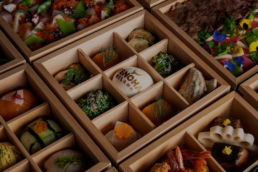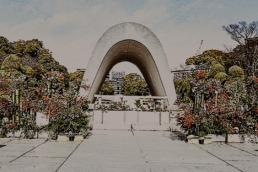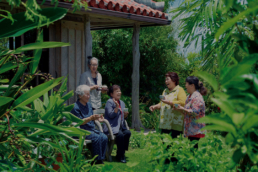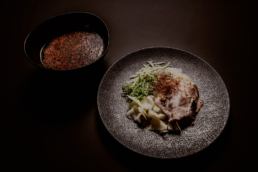Business Focus: Digital transformation, the key to increase the economy
This pandemic has hit the world economy hard and one of the keys to recovery is digital transformation. Let's continue our business focus and today we are talking about just how much an online presence can influence the economic development of Italy and Japan.
The Digital transformation: could it be the key to increasing Japanese consumer spending?
Author: Erika
In recent months, many companies have launched themselves into the digital world and many shops have transported their windows into the area of e-commerce. This clever move has allowed them to continue working even during the months of lockdown, and not to stop their production.
However, in Japan, as well as in Italy, the economic recovery has slowed down considerably. For what reason? The reason for this is that in both countries the spread of e-commerce and online presence is lagging far behind other countries.

During the months of the lockdown, people drastically reduced their visits to shopping areas. However, in OECD (Organisation for Economic Co-operation and Development) countries, retail sales have increased and on average above the pre-pandemic level. This means that the majority of sales were made through online sites and e-commerce.
The situation is different not only in Italy but also in Japan. Here, sales are still below the levels recorded before the pandemic. In these two countries that are so different and yet so similar, people have locked themselves in their homes without spending money. In fact, at the end of June, Japanese households' cash and bank deposits reached a record figure (1,030,000 billion yen).
However, this did not help the economy, which was already severely affected by the repercussions of COVID-19. According to some, this brake is due to the insufficient development of the e-commerce sector and the scarce online presence of companies in the two countries, both Italy and Japan.

In fact, according to a 2019 statist survey, only 16% of Japanese people said they had purchased online in the previous year. This figure ranks fourth among the 45 developing economies. It is therefore conceivable that once the digital transformation arrives in Japan, the potential for increased household spending could be enormous. In fact now, after months of pandemics and constraints, consumers are tired of staying at home and are willing to spend.
How to get the digital transformation to Japan?
Everything we have said so far, are hypothetical speeches with enormous potential. However, in order to turn this potential into a real economic recovery, the government and firstly the companies themselves would have to invest in digital. We are referring to the creation of e-commerce, websites, social media channels and influencer marketing so that the business linked to these companies can restart.
In support of this theory, leading Japanese companies plan to invest 16% more in digital for the fiscal year 2020. In fact, a total of 765 companies aim to spend 471.8 billion yen ($4.45 billion) on technology, shows a survey Nikkei on listed companies and those with 100 million yen or more capital. This marks a second consecutive year of double-digit growth.
With the pandemic disrupting the flow of people and goods, companies are turning to technology to adapt sales and distribution channels to the new norm. Seven & Holdings, the company behind the 7-Eleven convenience stores, expects technology investment to increase 19.9% to 121.2 billion yen - the largest sum on the list.
Investments in technology have already borne fruit and a return on these investments that can only accelerate. In fact, the companies that have embraced the digital transformation are the ones that are doing the best in this pandemic.
"Business leaders are forced to adapt to the coronavirus, and now they realise the importance of digital transformation," said Saisuke Sakai of the Mizuho Research Institute. "IT investments could grow even more in the future." / source: Nikkei
This leads us to understand that now more than ever it is time to invest in digital and create an online presence for your company in both Japan and Italy. Only in this way, companies will be able to keep their work going and have constant sales even in these uncertain times.
Japan Italy Bridge keeps you informed about the suggestions for companies in our business focus feature, or you can find us on facebook and tell us your opinion. Alternatively, you can join our newsletter or request a quote on our services to communicate your company in Japan and Italy and be part of the digital revolution.
Contemporary Japanese artists abroad
Japan, like Italy, is a country very attached to art and many contemporary Japanese artists have exported their works abroad.
Contemporary Japanese artists abroad
Author: Sara
Museums, art fairs and expositions have allowed the Japanese contemporary art world to look outwards. At last, even great artists are going out beyond the borders of the Rising Sun. We at Japan Italy Bridge have decided to introduce you to some of the most important contemporary artists who have received worldwide acclaim. We are talking about creatives like Yayoi Kusama, Tatsuo Miyajima, Takashi Murakami, Yoshitomo Nara and Hiroshi Sugimoto. Are you ready for this trip?
Yayoi Kusama

photo credits: wsj.com
Born in Nagano in 1929, Yayoi Kusama is perhaps the best known among Japanese contemporary artists. She began to show her immense artistic talents at the age of 10. The difficult relationship with her mother and trauma that deeply affected her led Kusama to paint her experiences on the canvas. The physical environment and her personality vanished swallowed up by the space that moved at an incredible speed. She also began to draw inspiration from Georgia O'Keeffe and wrote a letter to her. The artist replied and Kusama moved to New York where he began making monochrome paintings that immediately attracted attention.
The early 1960s were certainly not easy for a woman, especially a Japanese woman, and being able to exhibit in galleries was a difficult undertaking. However, she did succeed and became increasingly well known in the field of conceptual art. Her works include attributes of feminism, minimalism, surrealism, surrealism, art brut, pop art and abstract expressionism, all united by the polka dot technique.
Back in Japan, the artist was able to enjoy the success she deserved. Her works were exhibited at the Museum of Modern Art in New York, the Tate Modern in London and the National Museum of Modern Art in Tokyo. Between 1994 and 2012, Kusama collaborated with the musician Peter Gabriel and especially with Marc Jacobs, artistic director of Louis Vuitton. Kusama now lives in the Seiwa Psychiatric Hospital in Japan by personal choice and continues to paint daily in his studio in Shinjuku.
Tatsuo Miyajima
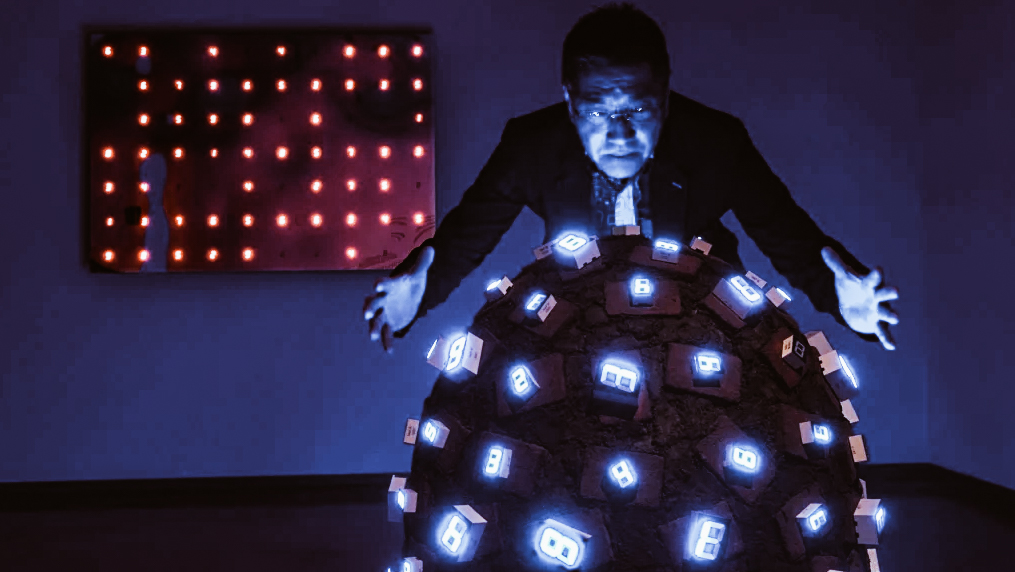
photo credits: smh.com.au
Born in Tokyo in 1957, Tatsuo Miyajima graduated from the oil painting course at the Fine Arts Department of Tokyo National University of Fine Arts and Music. He began experimenting with performance art before moving on to light-based installations.
Miyajima stated that the desire to create more lasting work, in contrast to the necessarily ephemeral nature of his performance and actions, motivated him to start working on sculptures and installations. Using contemporary materials such as electrical circuits, video and computers, Miyajima's highly technological work focused on the use of digital light-emitting diode (LED) counters. These numbers, flashing in continuous and repetitive cycles from 1 to 9, represent the journey from life to death, whose purpose is symbolised by the "0", a number that never appears in her work.
Miyajima has had solo exhibitions at the Ullens Center for Contemporary Art in Beijing, the Miyanomori Art Museum in Hokkaido, and the San Francisco Museum of Modern Art. She has also taken part in the Venice Biennale and numerous group exhibitions, from the Museum of Contemporary Art in Sydney to the Hiroshima City Museum of Contemporary Art. Since 2006 Miyajima has been Vice President of the Tohoku University of Art and Design.
Takashi Murakami
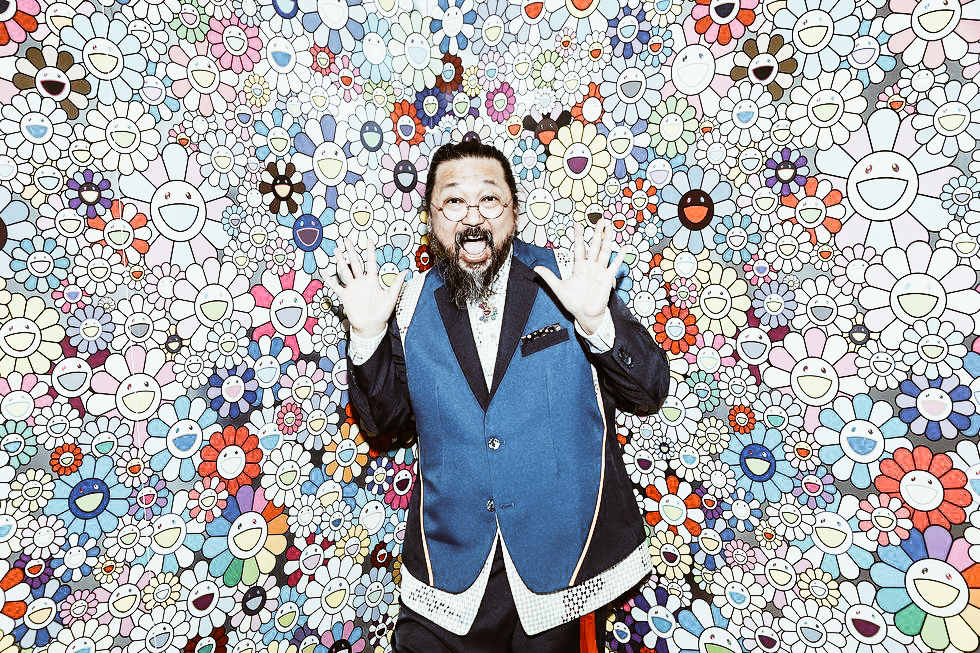
photo credits: crfashionbook.com
Born in Tokyo in 1962, Takashi Murakami began his studies of traditional Japanese painting at Tokyo Geijutsu Daigaku. However, his aspiration was to become a great mangaka. After graduating with a degree in traditional Nihon-ga painting, he won a MoMA PS1 scholarship. He moved to New York enriching his influences with the works of Andy Warhol and drawing inspiration from the production philosophies of film companies such as Disney, LucasFilm and Hayao Miyazaki's Ghibli Studio.
Among the various solo exhibitions, there is one that will mark the birth of a new Japanese art movement: "Superflat". This was the title of the exhibition at MOCA in Los Angeles which became the artist's programmatic and aesthetic manifesto systematically promoting the value of Japanese art independent of Western influences. An art capable of expressing the cultural reality of the new Japan. Superflat in fact mixes otaku elements with Kabuki and jōruri elements, fused and flattened into images with smooth surfaces and brilliant colours in which the aesthetic themes are amplified and exalted.
Murakami collaborated with Marc Jacobs and created the limited-edition Cherry Blossom bag for Louis Vuitton, designing for the occasion a kawaii pattern with the monogram of the fashion company.
Thanks to his aesthetic and entrepreneurial approach to art, Murakami has fully entered the international elite art scene, selling through third party companies, objects destined for the mass market, inventing and promoting the Kaikai Kiki and GEISAI brands.
Yoshitomo Nara

photo credits: scmp.com
Born in Hirosaki in 1959, Yoshitomo Nara studied at the Prefectural University of Fine Arts and Music in Aichi and at the Kunstakademie in Düsseldorf.
Nara is known for his paintings whose subjects are deceptively simple. We find children and animals in pastel colours with cartoon-like features with little or no background that appear both sweet and sinister. They also sometimes wield weapons such as knives and saws and their looks are accusatory. His art is a metaphor that accuses people of attacking the innocence of childhood.
Nara's objective perversions are rooted in Japanese popular culture, but these influences are mixed with those of Eastern and Western society. Her paintings, sculptures, installations and engravings explore the themes of isolation, rebellion, spirituality and religion.
Hiroshi Sugimoto
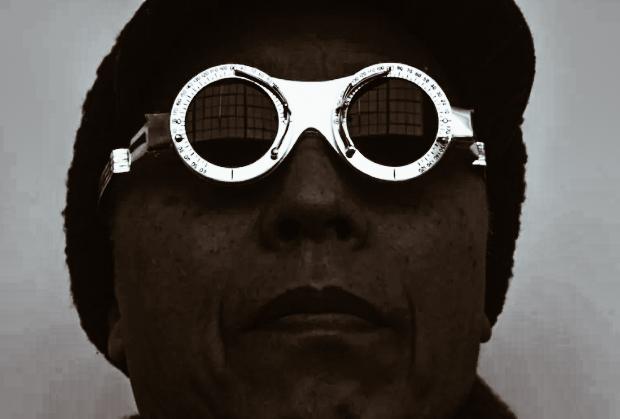
photo credits: artslife.com
Born in 1948 in Tokyo, Hiroshi Sugimoto, after obtaining his Bachelor of Arts degree, moved to Los Angeles to study photography. These studies led him, in the 1970s, to establish himself as one of the most famous contemporary photographers.
His work deals with history and temporal existence, investigating themes such as time, empiricism and metaphysics. Sugimoto has received numerous grants and his works are exhibited in the collections of the Tate Gallery, the Museum of Contemporary Art, Chicago, the Metropolitan Museum in New York and the Guggenheim in New York.
Like many contemporary artists, Sugimoto has collaborated with fashion, this time with the French company Hermès. Sugimoto's colour photos for Hermes' foulards were exhibited in June 2012 at the Museum of Cultures in Basel. During the 2014 Venice Biennale, Sugimoto unveiled his "Glass Tea House Mondiran" at Le Stanze del Vetro on the island of San Giorgio Maggiore.
The art world is full of facets given by continuous inspirations, by the search for the ego, by the need to express profound concepts without the use of words. Which of the contemporary Japanese artists have impressed you the most? Let us know in the comments!
TENOHA MILANO: The Bento Experience
TENOHA & | TASTE always manages to amaze us, the new bento experience is waiting for us at TENOHA Milano to give us an adventure and an absolutely new and exciting experience!
Bento Experience @ TENOHA MILANO
Author: SaiKaiAngel
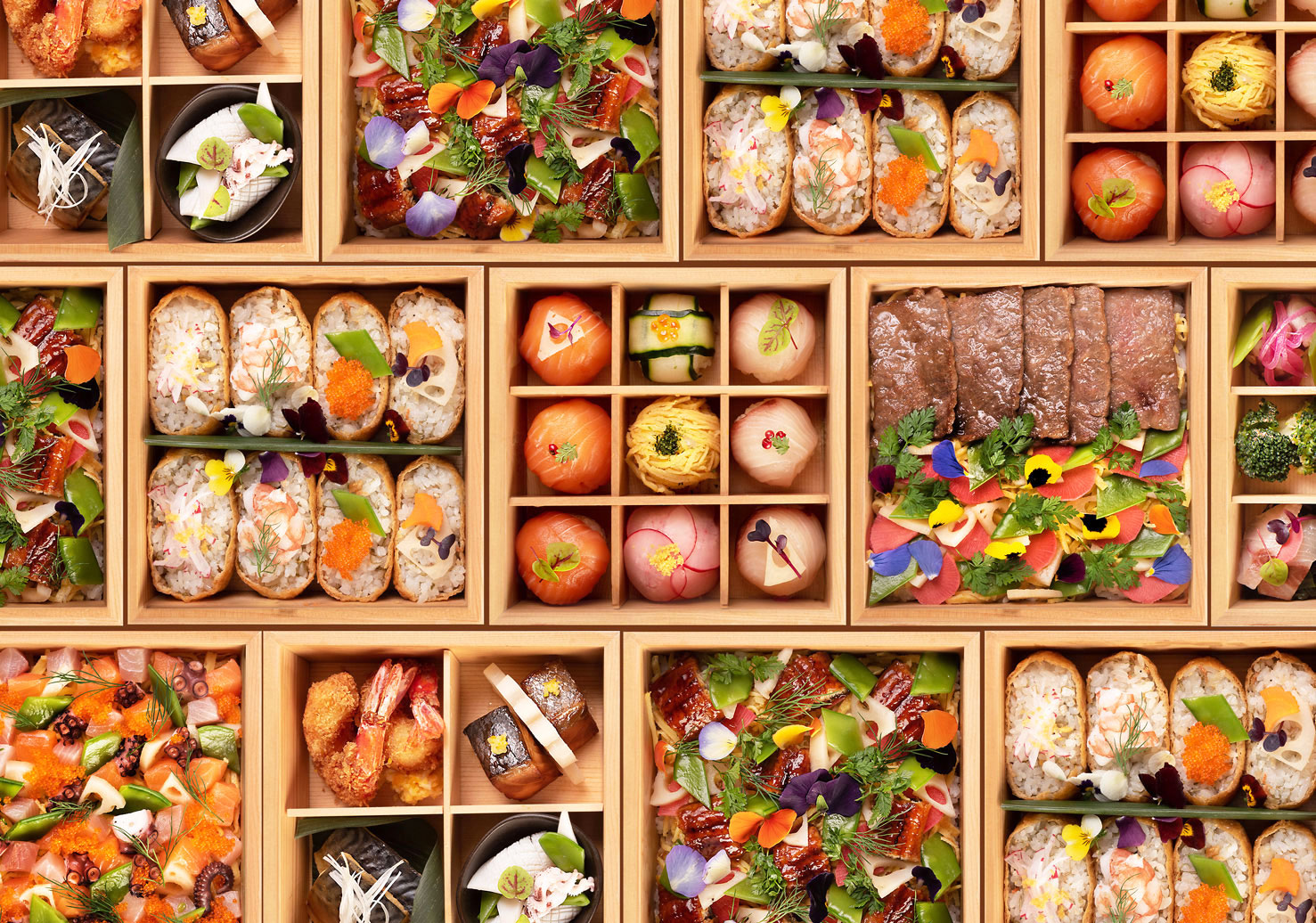
We are talking about the new exclusive delivery of TENOHA & | TASTE! Thanks to the JAPANESE EXPERIENCE you will be able to have directly at your home a complete Japanese meal decorated and packed with furoshiki! Thanks to the Japanese principle of nutritional balance (MAGOWAYASHII まごわやさしい ) you will be able to have Japan in your home whenever you want! All the taste of Japan, wooden bento box packed with furoshiki.

The Japanese experience at home! A complete Japanese meal directly on your table! I recommend it! With regard to same-day orders, we accept only with good notice: LUNCH by 9.00 / DINNER by 15.00.
Delivery with free local delivery takes place only within a maximum radius of 5 km from TENOHA, in the city of Milan.
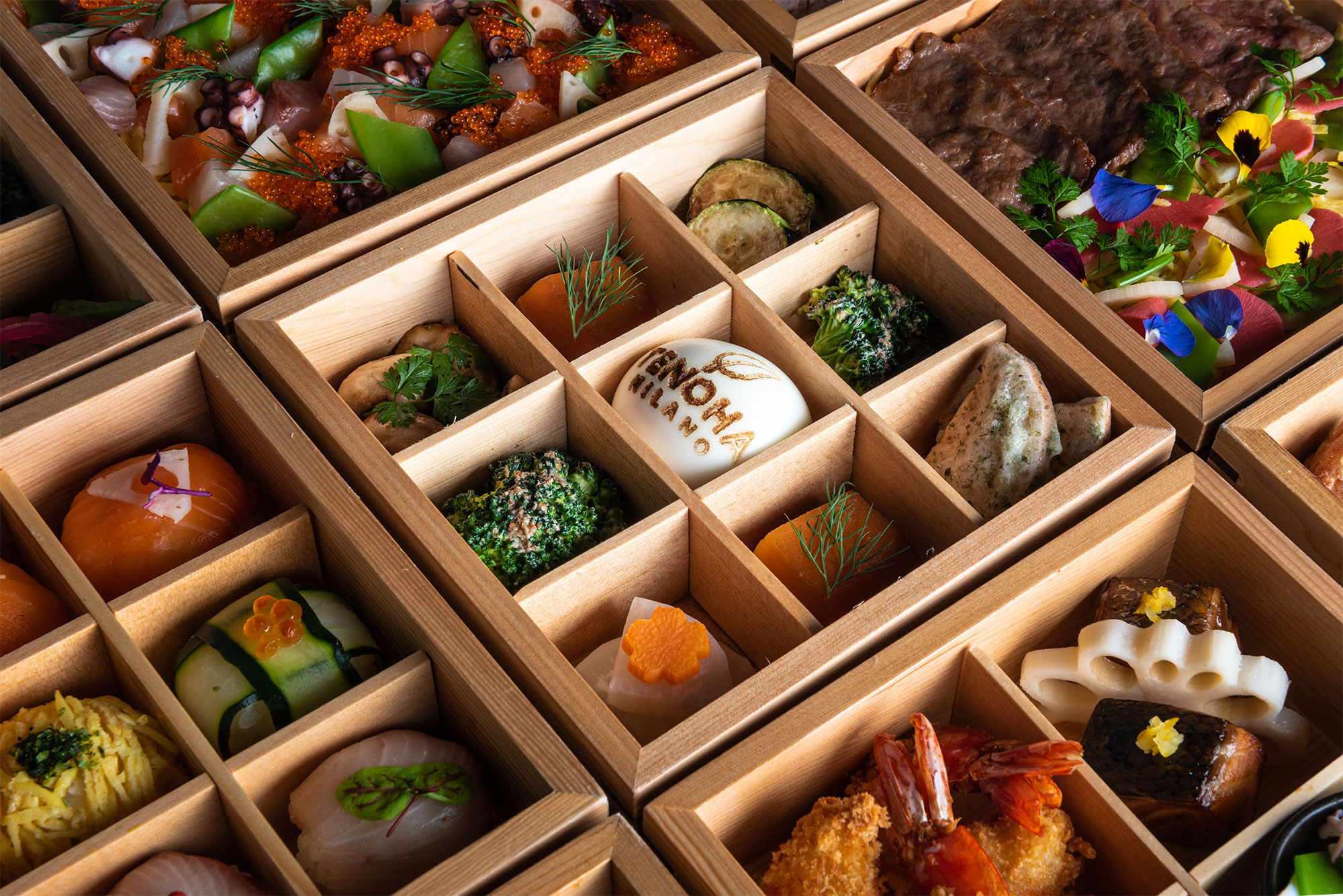
Delivery hours
THU – SUN
Lunch 12:00 – 14:30
Dinner 18:00 – 21:00
For the return of the bento box, no problem! The day after the delivery, the driver of TENOHA Milano will come back for the collection of the empty bento box, the glasses and the furoshiki. You can agree now and how directly with the driver.
But how is the Bento Box and the Japanese experience like? Food, atmosphere and drinks all Japanese, let's see more in detail! The bento box consists of various steps and layers of your choice:
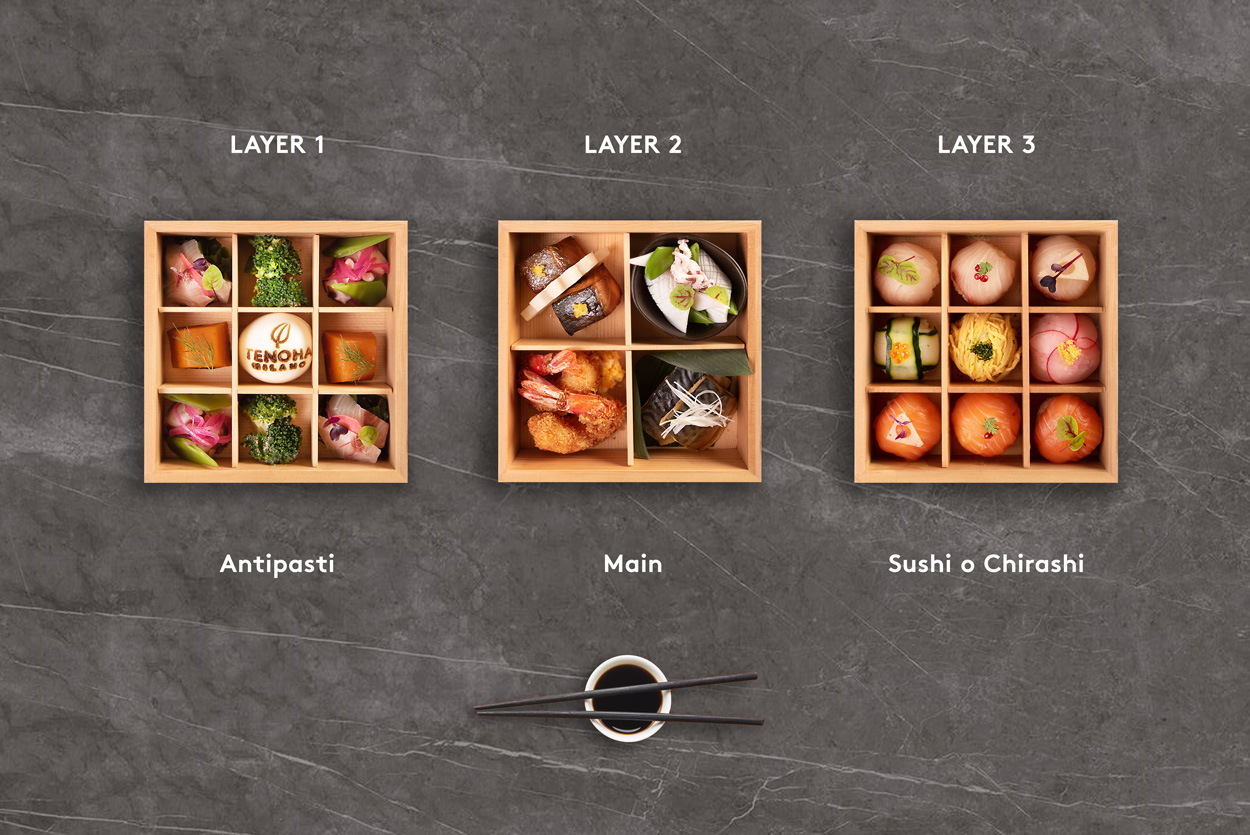
Step 1
For layer number 1 you can choose between fish option and vegetarian option
Step 2
For layer number 2 the choice is between meat or fish
Step 3
In layer 3 the choice becomes more and more interesting, between Temari sushi, Inari sushi, Chirashi Wagyu, Chirashi Unagi and Chirashi Kainsen
Step 4
In step 4 here are the drinks directly from the Rising Sun: SAKE HATSUMAGO, SAKE SENPUKU, WHISKY TOKI, WHISKY AKASHI, JAPANESE TRADITIONAL BEER SET
To learn more, visit this link so you can choose the experience that suits you best and create your own Bento: ORDER HERE
So, TENOHA Milano gives you the opportunity to choose your Japanese experience right at home! Do not miss this opportunity and live this moment with a smile! Enjoy Japan at home, we at Japan Italy Bridge are able to work well also thanks to this Japanese atmosphere that only TENOHA Milano can give!
photo credit: Anna D’averio
Business Focus: Digital events during the pandemic
In 2020 we had a very special year and also for those who like us work in marketing there was an invasion of digital events. We experienced new ways to stay in touch, new ways to embrace each other, new ways to study and work. These are not ways of living and working that we should never have known, on the contrary! The year 2020, said in a very positive way, has accelerated many of these processes. What can the positive pandemic bring us? Surely, looking at the situation, we can answer with "very little", but let's try to look beyond everything.
Digital events: opportunities during the pandemic
Author: SaiKaiAngel
Did this 2020 make the leap into the future shorter? Definitely yes! As for us at Japan Italy Bridge, for passion or need, we made sure to stay afloat and continue to present our proposals ... online!
Anyway, we were already organized and prepared for this, considering the sentence we always said when introducing ourselves as "The future is online". Now, we are sure that that phrase, which we were waiting for it to become our daily heritage maybe in a while, has suddenly become customary good from this moment! We at Japan Italy Bridge are committed, waiting to be able to physically embrace you again, to build and propose digital events and situations that can give you emotions, if not equal, but similar to physical ones.

We have experienced, during the lockdown, many online events such as school, work, webinars, meetings, often seeing them as something new and more exciting than the online presence. Why? Simply because we are facing something new. Before we get used to this too, let's try to exploit the enthusiasm in all its essence.
Digital Events
Let's talk about online events, for example. Yes, because apart from the online work we have always done, events were the only thing we kept offline and based only on the presence of people. While waiting to do it again, we looked for online solutions that could actually, for the moment, create if not the same enthusiasm, something similar.
How do you organize an online event?
First of all, you have to focus on the guests, just like the event in the presence, nothing changes! You have to identify the people who might be interested in that event and become an interesting link for companies that want to communicate their work to others.
What is the main goal of the online event?
The online event, like the offline one, is to reach as many interested people as possible. You have to make sure that you create the right platform and the right place for them to best facilitate their presentation and communication with other participants. The online event, therefore, becomes a favourable place to exchange opinions that can then become a tool for the contact between companies. One of the positive things we find in this is the reduction of organizational costs. It then becomes completely free without any problems of audio, lighting, culinary entertainment. The most important thing is to have a platform capable of holding and maintaining the event without problems and, certainly, a good connection. Among the most popular platforms are zoom and meet.
Another absolutely essential thing is the ability of the event's creator to entertain guests by ensuring that spaces and moments can be respected. In this case, we need a good "host" who is not very different from those we see on TV programmes. The presenter must be able not only to ensure that the times are respected but also to keep the enthusiasm high for the entire duration of the event, intervening when the situation fades away or when it becomes too bright. Nothing so different from the offline event, in short. This is proof that the creator of the event is part of a consolidated company capable of dealing with any type of situation.
At Japan Italy Bridge, for example, we focus on creating a bridge, as our name suggests, between Japan and Italy. Until this bridge can be built physically, as we have already done with our previous events, two random names "Japan meets Italy" and "Spindle". we are very keen to keep the interest and communication between these two nations high. For this reason we have studied how to make our events online and interesting.
Obviously, one of the things we think may be essential for a digital event, is not the payment, but at least the registration. Registration will allow us to have a closed list of participants and a beginning of moderation. The registration should at least contain the basic information: name, surname and an email to be contacted. In this way, you will be able to have not only a certain moderation of the event, but also a way to communicate suitable for your profile. The guest will not find a bedlam of people who are not interested in anything about the event, but only and only guests interested and enthusiastic to participate, listen and share.
Listening and sharing
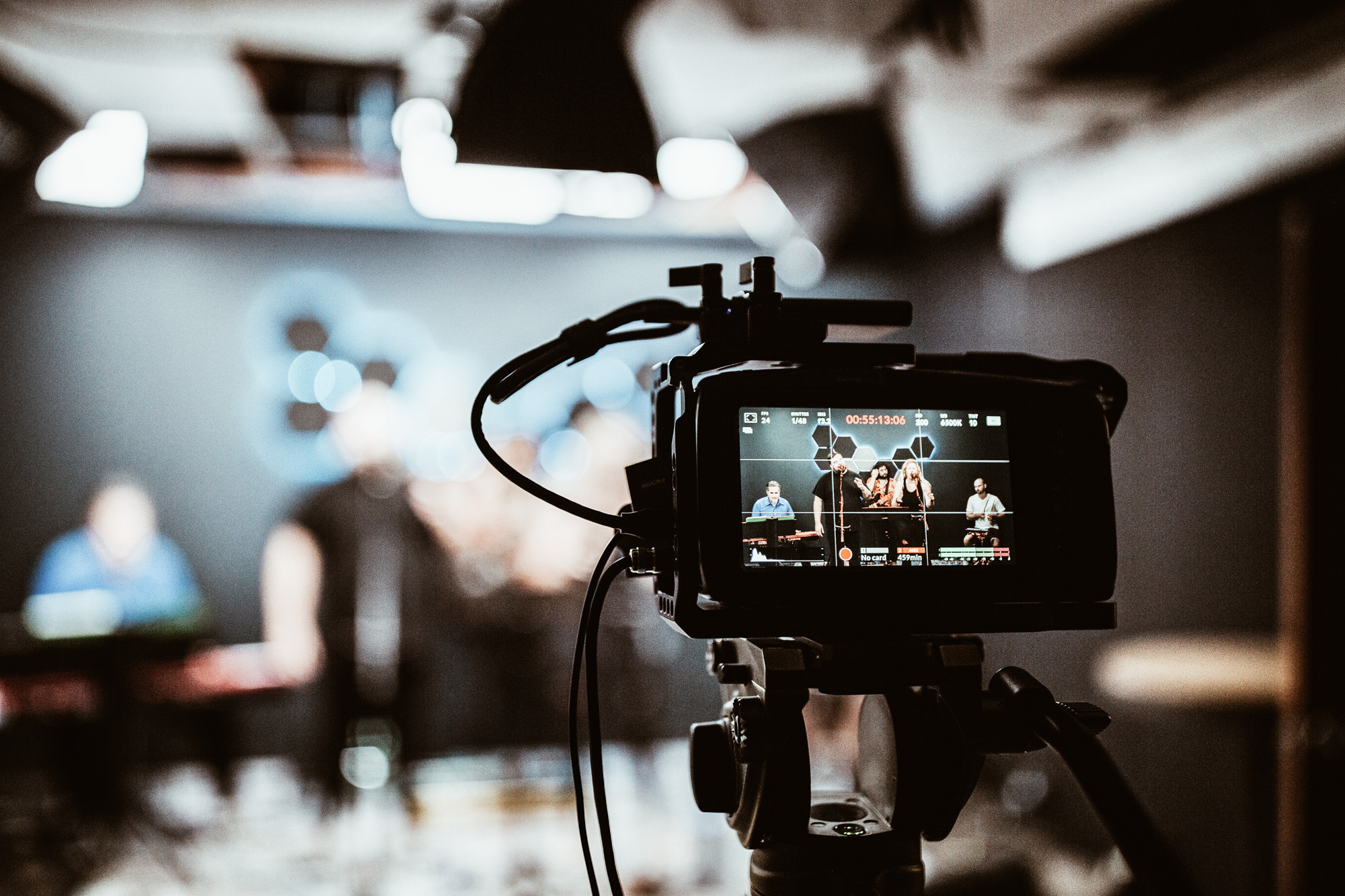
Let's not go so far from the offline event, in this case, the focus is always the same: finding people and companies interested in sharing. We all know how difficult it can be to connect companies of different nationalities, but we are also sure that Japan and Italy have a lot to share and feel united, otherwise, we would not do this job!
The online event should not be scary, if we look at this carefully, we will realize that it is not so different from the event in presence.
So what do we need to create an online event?
- Identify people and/or companies that might be interested in the event.
- Create the right environment to facilitate communication between them, perhaps by establishing a dialogue first.
- Leave the guests in the right place and moderate the time available to them in order to make it the same for everyone.
- To have a good interlocutor and manager of the event that can enforce time moments and keep up the enthusiasm of the audience.
- To have the conviction to do the right thing, without being frightened by the difference between offline and online.
Whether it is on a digital platform and in presence, many things remain the same, one of which is enthusiasm.
Never lose your enthusiasm, it is what will allow you to live properly at any time, making the waiting less heavy and above all fruitful. You will learn to "feel" the enthusiasm of the other person and also to create new connections. make it a new challenge!
As for us at Japan Italy Bridge, we are ready to continue to build this bridge also digitally and then continue to do it in person.
Business Focus: E-commerce after the pandemic
The effects of the Coronavirus are still being felt, however, we are not talking about positive cases but about online presence and e-commerce. We continue our Business Focus features and today we are talking about how e-commerce platforms have influenced this 2020 and how they will influence our future.
The importance of e-commerce during and after the pandemic
Author: Erika
During this 2020 we understood how extremely important it is to have an online presence, for any company, even more so for shops. Not only social media but above all e-commerce has also depopulated due to the pandemic. With the forced closure of shops, in fact, many businesses have found themselves having to run for cover and create an online presence very quickly.
The impact that the lockdown has had on the habits of us Italians, but also of the entire world population, is extremely evident. In fact, in recent months, e-commerce has become one of the main channels to buy essential products without having to leave home.
We can in fact see from the data how between February and March 2020 online sales in Italy grew significantly compared to the same period in 2019. The favourite moments for Italians to shop are during the weekend. Precisely because of the coronavirus epidemic (COVID-19), on 8 March online sales increased by 90% compared to the same period of the previous year.

Some data
According to the GfK Consumer Panel, almost 4 out of 10 Italian households made their first online purchases in March. While, from the beginning of the year to date, 2 million new online consumers have been registered in Italy (out of a total of 29 million).
Between February and March 2020, online sales in Italy grew significantly compared to the same period in 2019. In fact, compared to the first six months of 2019, the total amount was 700,000 new consumers.
According to a recent survey conducted by Ipsos on the impact of the Coronavirus pandemic on individuals' attitudes and behaviour, in Italy, 31% of respondents said that the frequency of buying goods online has increased. On the other hand, almost half of the respondents stated that their frequency of online purchases has not changed at all.
Thanks to the COVID-19 pandemic, online retail platforms experienced an unprecedented increase in global traffic between January 2020 and June 2020, even surpassing the Christmas holiday traffic peaks. Overall, retail websites generated nearly 22 billion visits in June 2020, compared to 16.07 billion global visits in January 2020.

In short, having an online shop is now an inevitable option for any business. Moreover, according to analysts, the online commerce sector is the one that will grow the most in the world economy, with an increase calculated up to +55%.
This is precisely the time to equip and invest in digital technologies and focus on digital transformation. Adapting your services to online sales is the smartest move to make at this moment in history.
The cornerstones of a perfect e-commerce
By now we already know that the online consumer is much more demanding and sometimes more suspicious than the classic customer who visits us in the shop. However, user satisfaction is one of the fundamental cornerstones of a good e-commerce. Reliability and quality of service, user-friendly interface and customer service are fundamental points.
In addition, there can be no lack of excellent communication and marketing management specific to an online shop. Japan Italy Bridge not only builds high-level e-commerce but also communicates your brand online on various platforms. In fact, SEO optimization for an e-commerce and brand awareness help to increase sales and the customer's perception of the brand itself.
In particular, communication and marketing are the highest obstacle to overcome but also the focal point for the scope of an e-commerce. Investing in professional translations and a team that follows the social and digital marketing part helps to position your brand on search engines.
What Japan Italy Bridge recommends is to create a multi-channel system that will lead you to a winning e-commerce and increase your sales and revenues. together with that, you may also discover markets that were previously cut out of your sales strategy.
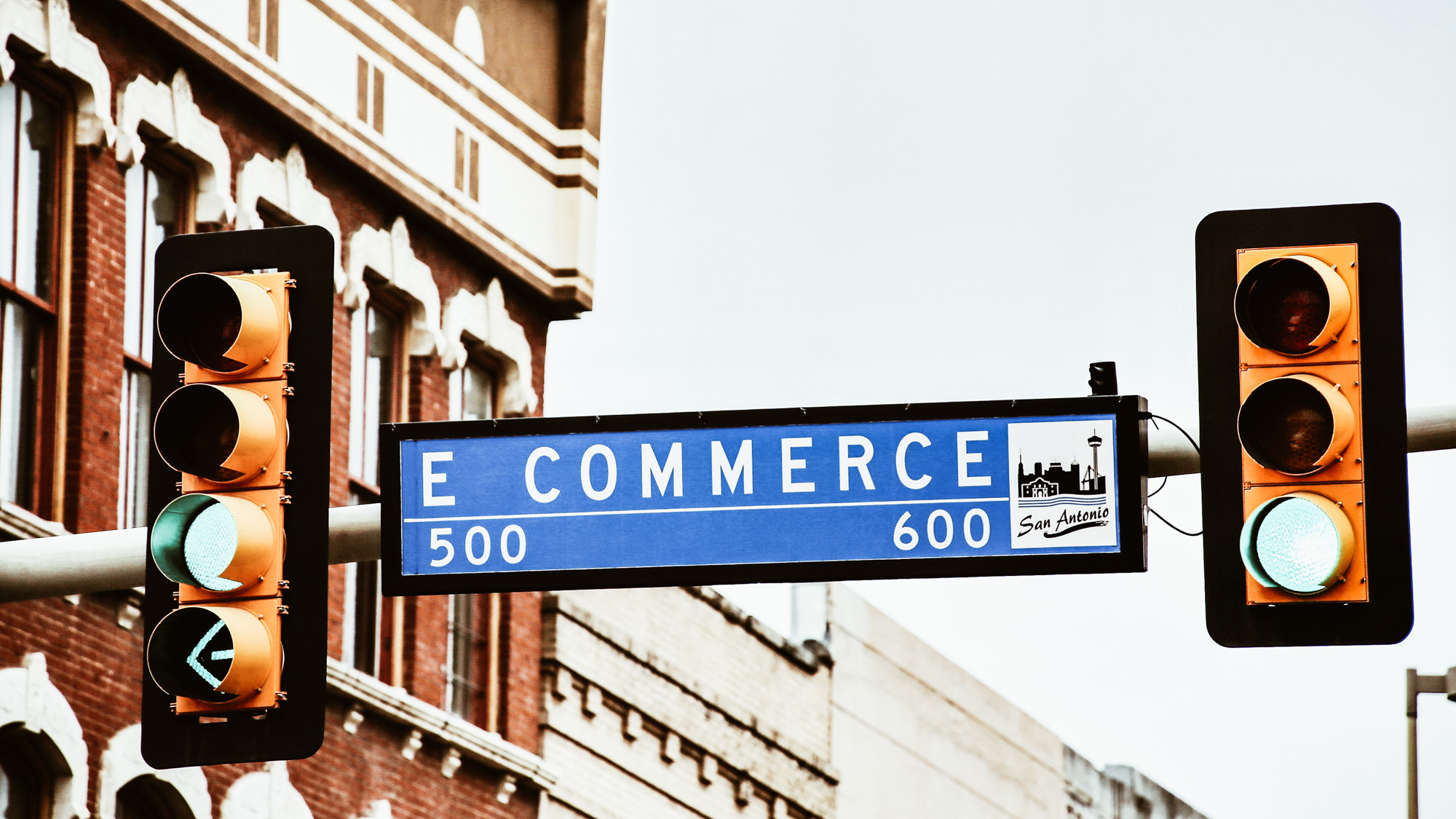
This COVID experience has taught us that we must always be ready for change and differentiate our presence on offline and online platforms. The way we sale our products and the means with which we do this have drastically changed. Virtual retail market has received disruptive effects that no one would have imagined until recently. This has had a major impact on the economy and organisation of many companies. Nowadays it is in fact normal not only to receive take-away food at home, but also other types of materials.
After the experience of the pandemic, it has become crucial to have an online presence. If your company is interested in building an e-commerce or interfacing with the digital audience, you can contact us and find out about our offers.
Hiroshima, a prefecture waiting to be discovered
Japan Italy Bridge promotes Japan and creates a real bridge between Japan and Italy and today we focus on Hiroshima. The Japan National Tourism Organization promotes tourism and this month focuses on Hiroshima prefecture. Let's give a more in-depth look.
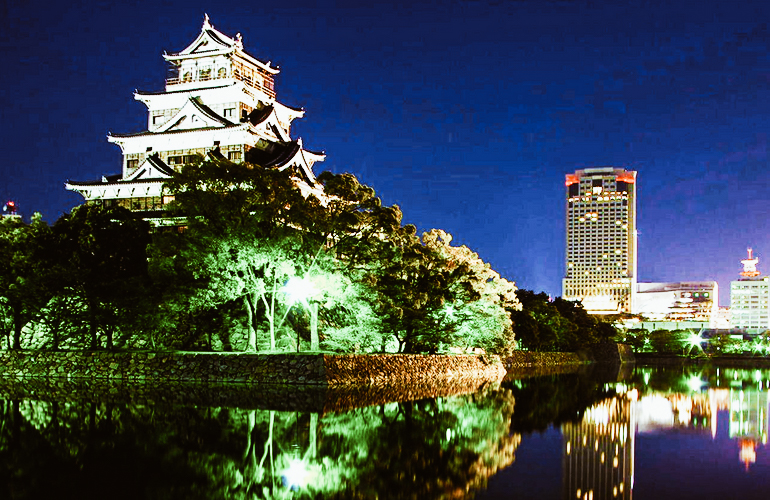
Hiroshima, a prefecture waiting to be discovered
Author: SaiKaiAngel
History

photo credits: un.org
The city of Hiroshima was founded in 1589, during the feudal period Sengoku by the Japanese daimyō Mōri Terumoto who made it the capital of his feud. After the battle of Sekigahara for territorial possessions, Terumoto had to surrender Hiroshima to the winner Tokugawa Ieyasu, who decided to have it administered by the daimyō Fukushima Masanori.
In 1871 the city became the capital of the homonymous prefecture and an important commercial and naval centre of Japan. At the end of the 19th century, Hiroshima witnessed further industrialization, which culminated with the war facilities erected during the Russian -Japanese war of 1904, and became Mazda's headquarters in 1920. In 1938 it became part of the broader war scenario of the Second World War. Unfortunately, on August 6, 1945, at 8:16 and 8 seconds, the bomb called Little Boy exploded at 576 meters, with a power equal to 12,500 tons of TNT. The nuclear explosion killed about 260,000 people and injured more than 160,000 in the months immediately following due to radiation.
The Territory
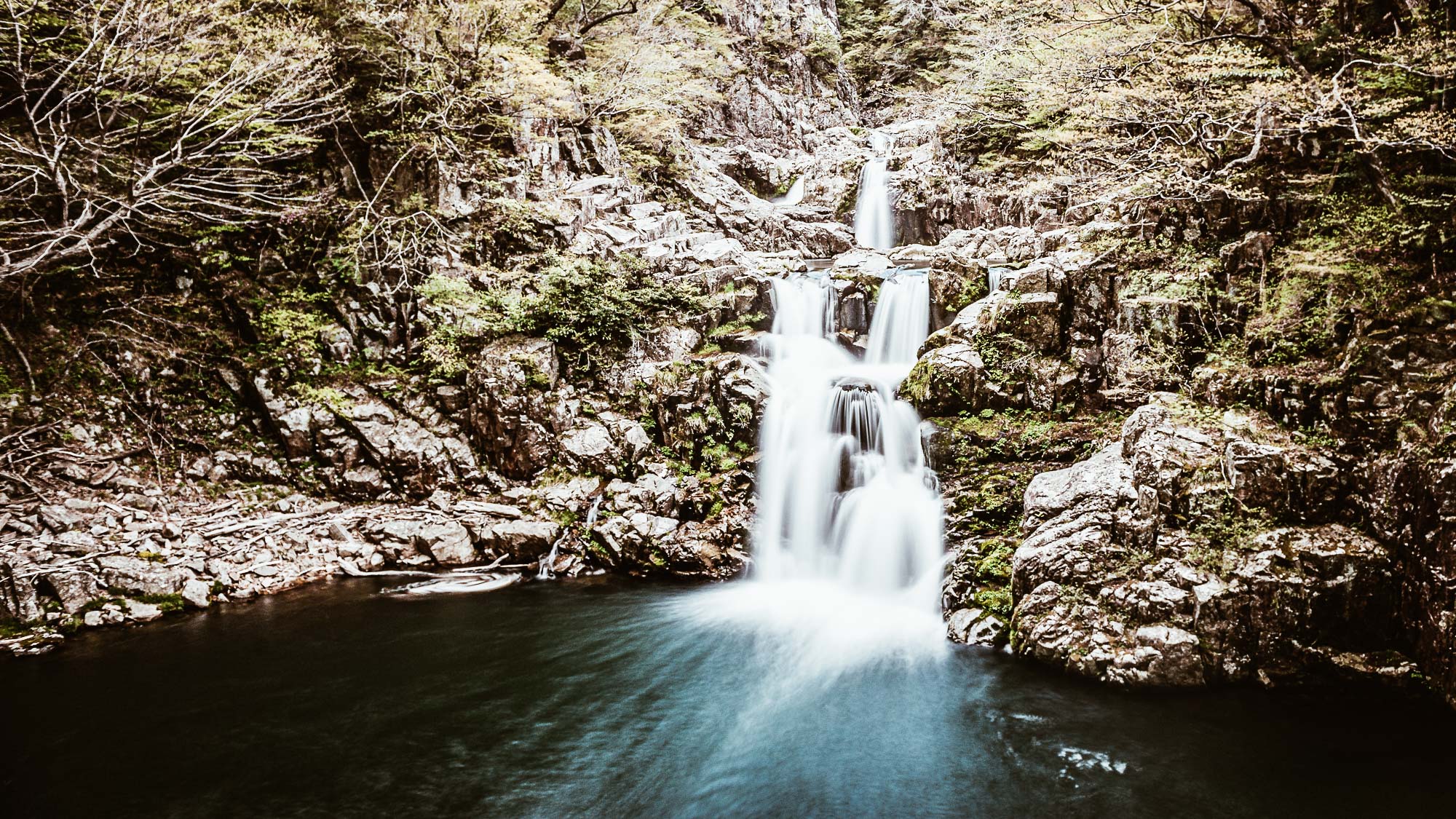
photo credits: locationscout.net
The centre lies on the harbour bay towards the sea of Aki-nada and the territory is hilly. Hiroshima has many islands such as Etajima-Nomi and Itsukushima and, inland, the territory becomes rockier with the Gosasou and Shiraki mountains as a road to the Ota River.
As JNTO also explains and assures, you can explore Japan in absolute safety! Visit Hiroshima without fear and in complete peace of mind, you will always be guaranteed the right distance, temperature detection in shops and places of interest, protection such as the mask. Do not risk anything, as the first interest of the person and the tourist there is always safety in every place.
Take advantage to visit this beautiful prefecture that gives us not only great emotions but also enchanting places that you will remember forever. Despite the tragedy caused by the explosion of the atomic bomb, Hiroshima had doubled its pre-war population in 1974 and was considered the "peace capital" of the world. Hiroshima is home to important attractions to visit absolutely, let's see them in detail.
Hiroshima Peace Memorial Park
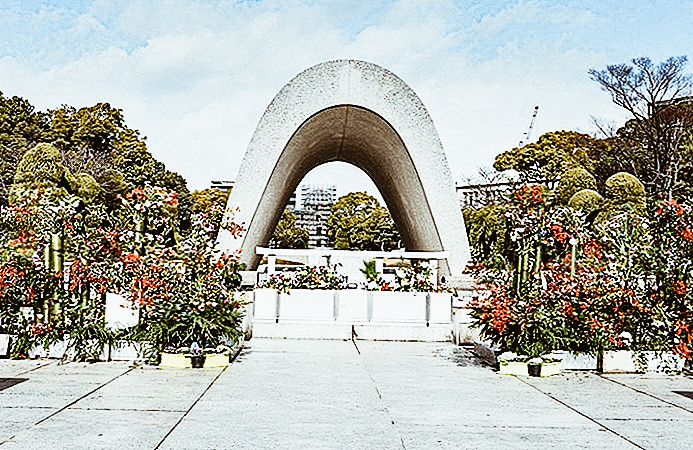
photo credits: theplanetsworld.com
Symbol of the need for eternal peace, it commemorates the numerous victims of the first nuclear attack and is located right in the epicentre of the explosion. Hiroshima Peace Memorial Park boasts many important monuments, museums related to the events of that day and its consequences. In addition to the beautiful gardens with their cherry blossoms, we find the Peace Memorial Museum, the Memorial Cenotaph, the Flame of Peace, and the Atom Bomb Dome with the ruins of the old Chamber of Industry and Commerce. A very interesting place is the Children's Peace Monument and the Monument to the victims of the Atom Bomb.
Shukkei-en Garden
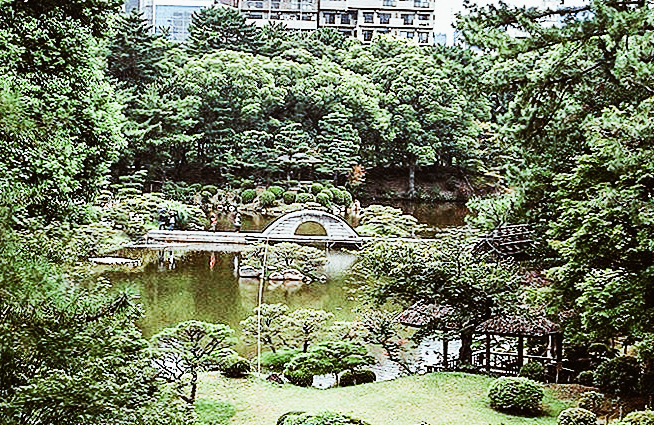
photo credits: theplanetsworld.com
The Shukkei-en Garden is a wonderful garden on the banks of the river Ōta. A space of peace and quiet desired by Asano Nagaakira in 1620. This garden was once the home of Emperor Meiji, and after the damage caused by the explosion in 1945, they literally flourished again in 1951 in all their beauty. The gardens opened to the public after being donated to the city in 1940 and, despite the heavy damage caused by the 1945 nuclear attack, the gardens reopened in all their former glory in 1951. Bridges, paths, a true landscape of calm and relaxation pampered by the sound of streams that draw from the river Ōta.
Hiroshima Peace Memorial Museum
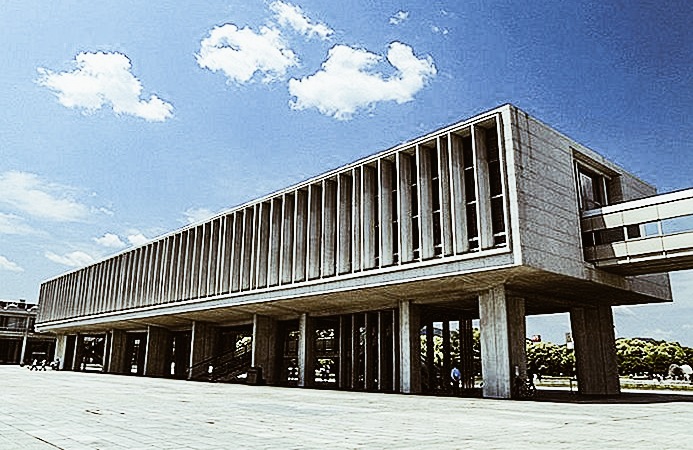
photo credits: theplanetsworld.com
The exhibitions focused on the explosion of the atomic bomb of the Peace Memorial Museum are very hard and very painful and are exhibited together with exhibitions that extol world peace. This museum is one of the sites that cannot be missed during your trip to Japan, both to experience the rebirth of a prefecture and to pay homage to those who lost their lives during the terrible bombing.
Hiroshima Castle

photo credits: theplanetsworld.com
The Castle of Hiroshima (Rijō), also known as Carp Castle, was the residence of Fukushima Masanori and then passed into the possession of the famous Asano Nagaakira in 1619. In the castle and in particular, in the tower, there is a museum about the history of the castle with images of Hiroshima. In the castle, we can also find three trees that survived the atomic bomb and a bunker used for radio transmissions after the explosion.
Itsukushima island sanctuary
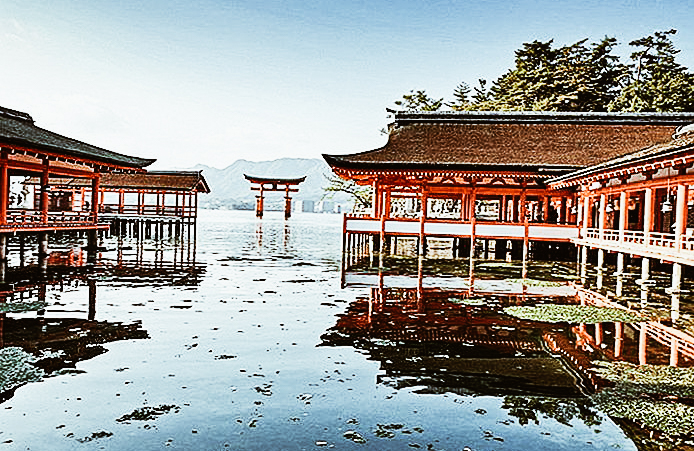
photo credits: theplanetsworld.com
Miyajima, the Sanctuary Island, is famous for the sanctuary of Itsukushima, dedicated to the princesses Ichikishimahime, Tagorihime and Tagitsu-hime, daughters of the wind god Susanoo. The buildings with the high tide, seem to float magically on the water because they are located on a bay supported by stilts. The show is not to be missed, a feast of colours, red wooden structures and white walls. Honden (Main Hall), Heiden (the offering hall). Haiden (the prayer hall), Senjokaku (the Hall of a Thousand Carpets) and Takabutai used for the Bugaku and Kagura dances are the places you cannot miss during your visit to Hiroshima.
Memorial Cathedral for World Peace
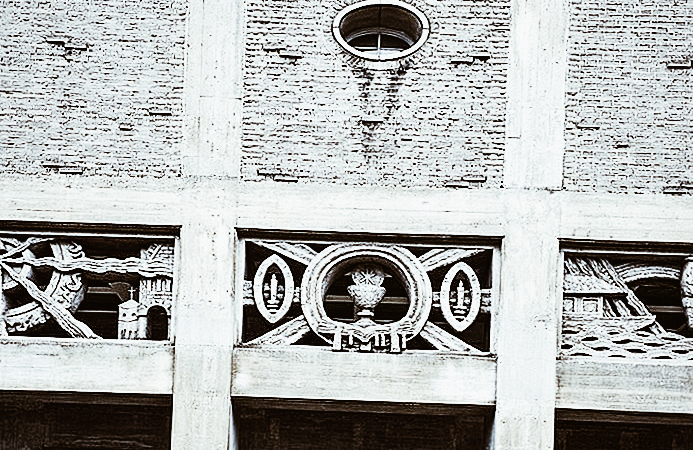
photo credits: theplanetsworld.com
The Memorial Cathedral is one of the largest churches in Asia, built in 1954 by German Jesuit priest Hugo Lassalle from a design by Japanese architect Murano Tohgo. The Memorial Cathedral has four bells in the 46-meter tower, an organ provided by the city of Cologne and the bronze doors of Düsseldorf.
The Mitaki-dera temple

photo credits: theplanetsworld.com
One of the most beautiful temples in Hiroshima is Mitaki-dera. Built in 809 and rebuilt after the war, it is also famous for its beautiful gardens, which in autumn give a fiery red show to visitors. Also known as the Temple of the Three Falls for its location at the foot of Mount Mitaki, the temple is famous for its red lacquer pagoda, Tahoto and waterfalls.
Fudoin Temple

photo credits: japanvisitor.com
Another beautiful place to visit is the Temple of Fudoin, the architecture of the Muromachi period between the 14th and 16th century with a large main hall containing a carved statue designated as a national treasure.
Hiroshima museums
The city of Hiroshima and the whole prefecture are also famous for the many museums in the area. Below are the ones that we believe are unmissable on your trip to Hiroshima.
Hiroshima Prefectural Art Museum (Hiroshima Kenritsu Bijutsukan)
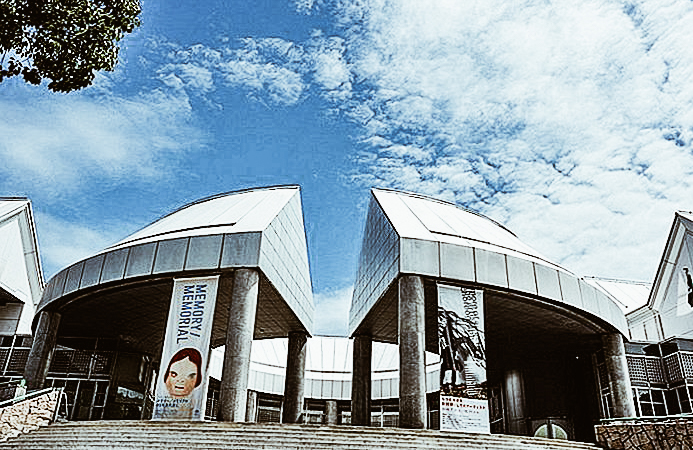
photo credits: theplanetsworld.com
This Museum, opened in 1968, focuses on local artists with collections related to the atomic bombardment and a children's gallery.
Hiroshima Museum of Art
The Hiroshima Museum of Art consists of eight world-class art galleries. We can find the collection of paintings by European masters such as Monet, Renoir, Degas, Maillol and Picasso together with leading Japanese artists such as Ryohei Koiso and Yuzo Saeki.
Hiroshima City Asa Zoological Park

photo credits: japantravel.com
Opened in 1971, the Asa Zoological Park is about 124 hectares large and is home to 170 species of animals, like minor pandas, Japanese giant salamanders, lions, giraffes and rhinos. A place to distract yourself from the other important places in Hiroshima and to entertain the mind, not only for children but also for adults!
Food and beverage
Obviously, with such an interesting trip, we can't forget to eat and drink and that's why Hiroshima gives us unique experiences here too! Not to be forgotten are five famous Sakaguras from Hiroshima thanks to which we can enjoy exceptional sake. Read carefully here for a unique experience in the Japanese tradition.
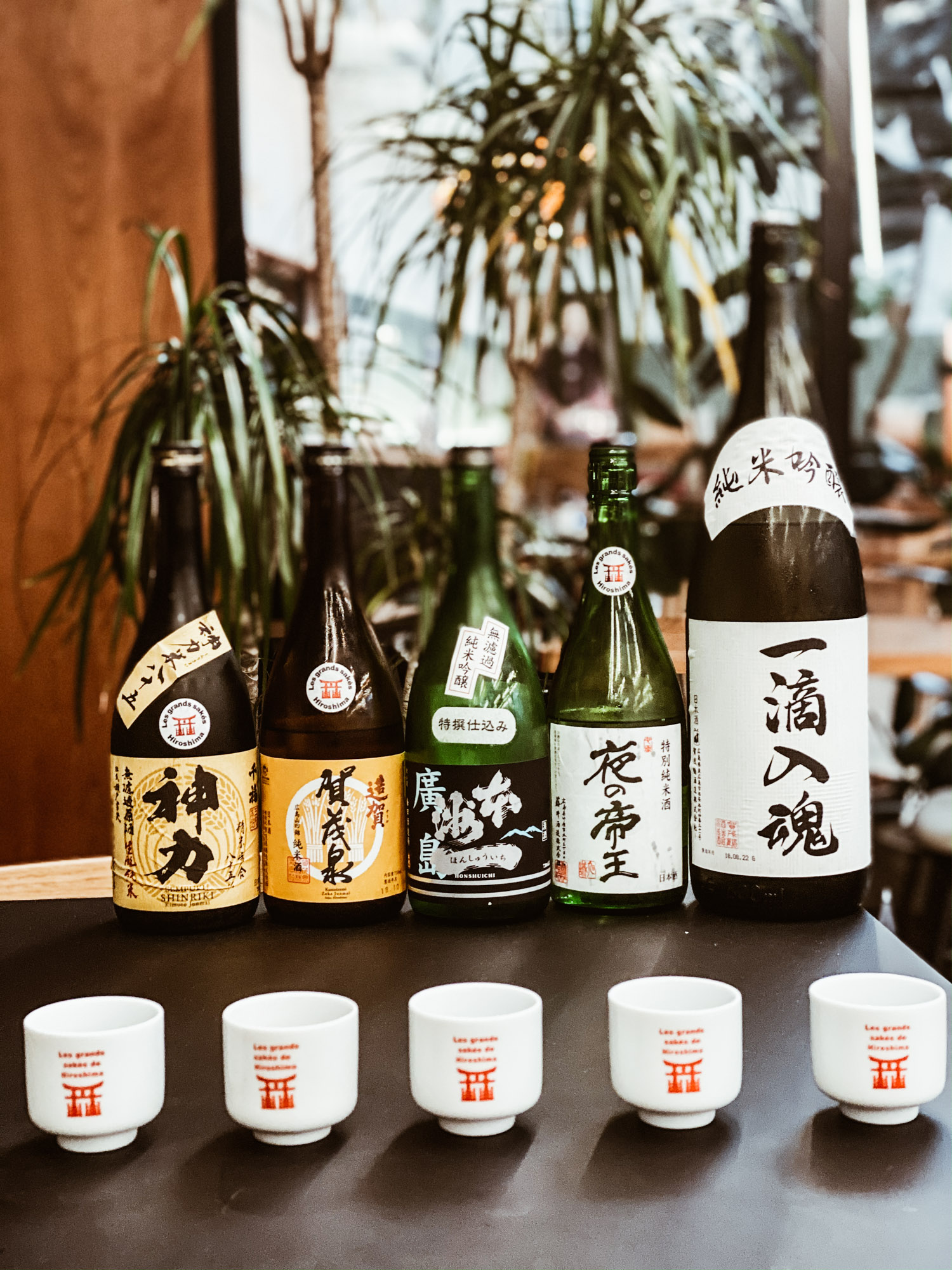
Honshu ichi - Brasserie UmedaCo., Ltd.
Category】Junmai Ginjo
【Ingredients】Rice, Koji rice (Senbon Nishiki / Hiroshima product)
【Polishing ratio】60%
【Alcohol content】 16.8 °
【Glucose density】 1.8
【Acidity】1.7
【Sake Gradation】 +5
【Aroma】Sweet fruity aroma
【Pairing】Fish in general, chicken, sweets with strong flavour such as cheesecake
【Features】
A Junmai Ginjo Sake produced by Hiroshima Prefecture, preparing "Senbon Nishiki" rice with Hiroshima Ginjo yeast. It is characterized by the fruity aroma of Ginjo sake, slightly sweet taste. It can be enjoyed with fish and cheese dishes.
‘Zoka’ - Kamoizumi Shuzo Co., Ltd. 創業 1912年 founded in 1912
【Category】Junmai
【Ingredients】Rice, Koji, Water (Rice: Yamadanishiki/100% Higashiroshima )
【Polishing ratio】65%
【Alcohol content】16°
【Glucose density】2.0%
【Acidity】1.8
【Sake Gradation】±0
【Aroma】Sweet chestnut, with a strong smell of rice and wheat.
【Pairing】Boiled tofu, sweet with citrus fruits, marinated food.
【Features】
Junmai Daiginjo is made from "Yamada Nishiki" sake rice grown in a field located about 6 km north of the brewery, using Saijo underground water and the Hiroshima Mori technique. The delicate aroma and sweetness of the transparent and gentle rice harmonize perfectly with the fresh acidity. You can enjoy it cooled with a thin cup or glass of wine. Sake certified with Saijo JAPAN brand)
Itteki Nyukon - KamotsuruCo., Ltd.
【Category】Junmai Ginjoshu
【Ingredients】Rice, Koji rice(100% Hiroshima rice)
【Polishing ratio】60%
【Alcohol Gradation】15 - 16 °
【Glucose density】1.0
【Acidity】1.6
【Sake Gradation】+3
【Sweet】Aroma
【Pairing】Sauté of chicken, Gelée of white peaches
【Features】
This sake has as first material the rice suitable for its preparation. A slightly dry Junmai Ginjo sake that goes well with foods with the right acidity, good both cold and hot.
Sempuku Shinriki 【Nickname】Filled with happiness - Brasserie MiyakeCo., Ltd. Sempuku Shinriki
【Category】Saké Daiginjo
【Ingredients】Rice, Koji (Shinriki) rice
【Polishing ratio】 85%
【Alcohol content】 19.0 °
【Glucose density】 1.2
【Acidity】2.3
【Sake Gradation】 +5
【Aroma】Mature aroma, almond
【Pairing】Sukiyaki, Steak, Cheese, Chocolate
【Features】
Kamiriki rice, which is the origin of Chifuku, is 85% processed and is close to the processing speed of rice from the Meiji and Taisho eras. A bottle full of feelings for the preparation of sake, especially suitable for people who particularly care about Japanese sake.
Night Emperor - Fuji Shuzo
【Category】Junmai
【Ingredients】Rice, Hattan Nishiki Koji, Water
【Polishing ratio】65%
【Alcohol content】 15 °
【Glucose density】N/A
【Acidity】1.6
【Aroma】Moscato, walnuts
【Sake Gradation】 +9
【Pairing】Tartare, Lemon Grilled Chicken
【Features】
Night Emperor is a mixed Hachitan Nishiki based liqueur produced in Hiroshima Prefecture. This versatile liqueur is easy to combine with any dish. Soft taste that takes advantage of the characteristics of fresh water preparation and keeps the alcohol content low while maintaining the taste of koji and rice. Good tasted both cold and hot.
We have given you some examples and information that will surely push you to live the Hiroshima experience, but there is even more! Hiroshima prefecture is a treasure chest full of treasures just waiting to be explored by you! What are you waiting for? We at Japan Italy Bridge do not make us repeat it twice, it will be a joy both for the eyes and for the palate and the heart and soul. We will all come out of it enriched!
Okinawa and The case of the over centenarians
The Japan Italy Bridge column continues to promote in-depth studies related to the world of Japan, today we are talking about Okinawa and the case of the over one hundred-year-old population.
"At 70 you are only a child. At 80 you are a young man. At 90, if your ancestors call you to heaven, ask them to wait until you are 100 years old. Then you can think about it". So says an ancient saying in Okinawa, unfailingly quoted every time you get ready to talk about its mythical inhabitants. Words that seem to find confirmation, even in ancient legends that would speak of this place as a "Land of the immortals".
Okinawa 沖縄 The case of the over centenarians
Guest Author: Flavia
A few years ago even the show "Le Iene" brought the case of Okinawa to prime time, giving us a very nice report. The longevity of its inhabitants and even more so the incredible quality of their ageing is immediately witnessed by the first two ladies who appear in the tv show. I think that whoever saw them was amazed: I don't lie if I say that they show something like 15 years less! Unbelievable. As noted by the journalist Nadia Toffa, sent by the tv show in question, we also have them here in Italy. So the point is, how do you get to those ages. That is: with what quality of life? Usually, the pains of our elderly people, as we know, are such as to affect the quality of their last journey of life. As a society, it is now accepted that illness and loss of autonomy are what is hopelessly awaiting us when we cross those age thresholds. Well, the case of Okinawa's (super-) grandparents shows us that things don't have to be like that! And that it is in everyone's power to ensure psycho-physical well-being during, starting from ... as soon as possible! The sooner you start to treat yourself, the better you can prepare for your old age.
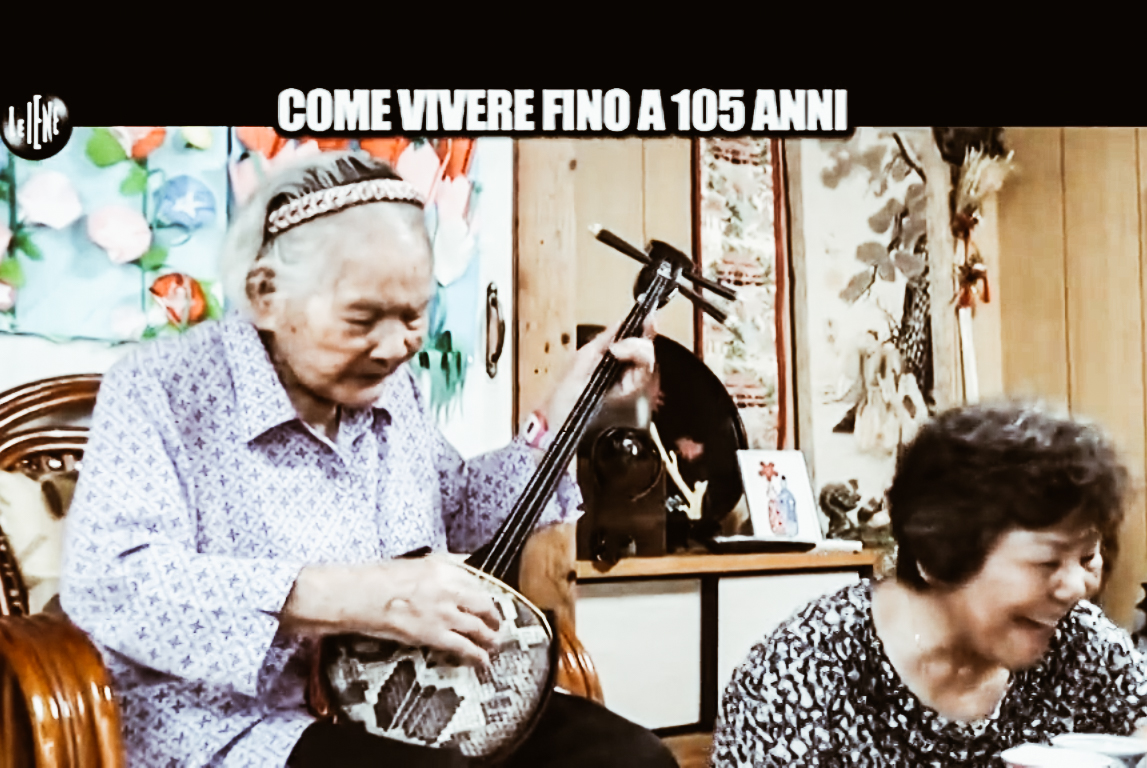
photo credits: mediaset.it
The typical ailments of our western societies - which often even young people(!) like to experience - Okinawa's elders almost don't know what they are. The incidence of diseases related to senility or degenerative diseases such as osteoporosis, Alzheimer's disease, sclerosis, cancer... is very low.
Okinawa: blue zone, paradise of longevity
These people have an extraordinary quality of life own on this island. We are talking about people who have never been to the hospital, who have never taken medication... who are even able to continue working or driving their car beyond the age of 90/95. Who in any case have a margin of autonomy unthinkable for a local elderly person, except in sporadic cases. Among them, the small village of Ōgimi stands out for the high concentration of centenarians compared to the total number of inhabitants. In reality, a case of similar longevity is present, you will know, also in our house: in the nearby Sardinia. Not by chance: Okinawa, Sardinia, the Greek island Ikaria, the Costa Rican Nicoya and a small community near Loma Linda in California, all fall under the name of "blue zone".
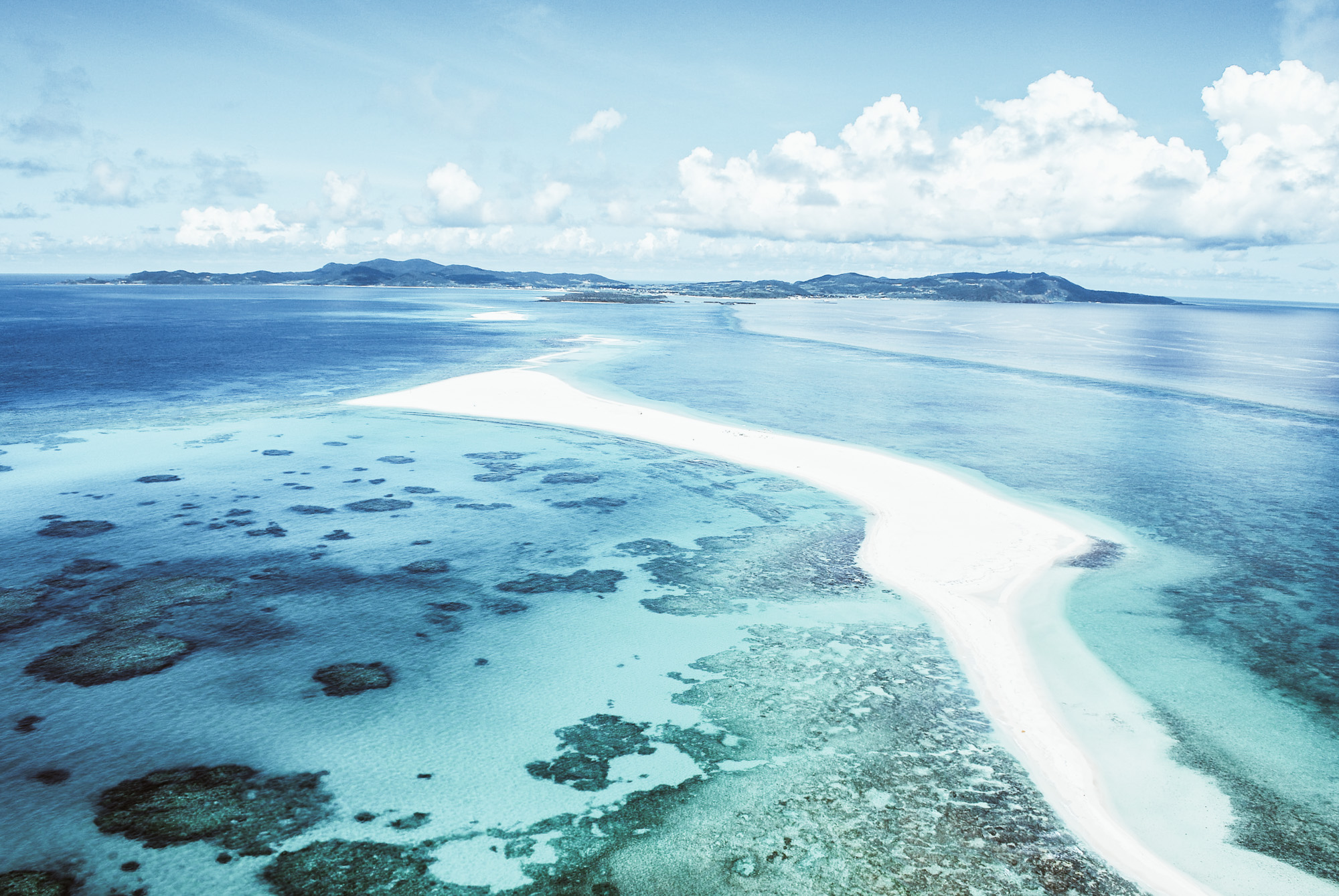
photo credits: ilviaggio.biz
Any area in the world where life expectancy is higher than the general average is called the "Blue Zone". Real "paradises of longevity" that attract researchers from all over the world to try to capture the "secret" of their populations. In this sense, Okinawa and its inhabitants even surpass even mainland Japan, which does not lag behind in terms of quality of life, but has a higher incidence of disease, for example.
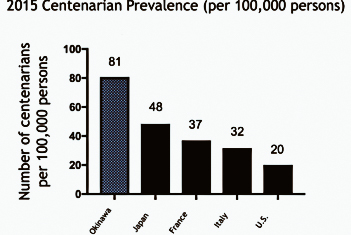 photo credits: orcls.org
photo credits: orcls.org
But who are the Okinawans? Let's first find out who we're dealing with.
Identikit of the Japanese "tropics"
Okinawa is the main complex ( 沖縄諸島 Okinawa-Shotō ) of the Ryūkyū archipelago and is located between "mainland" Japan and Taiwan. It consists of a main island of the same name plus other smaller islands. Naha ( 那覇 ), is its capital. It was named prefecture of Japan in 1879 although the Ryūkyū complex ( 琉球諸島 Ryūkyū -Shotō ), which incorporated it, was formally annexed in 1874. At that time Japan was in the process of modernization and this was matched by a process of unification of all the territories of the archipelago under a single flag.

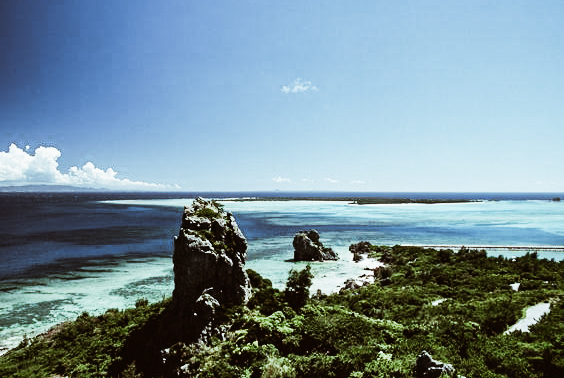
photo credits: lacooltura.com, pinterest.it.
Before 1874 Ryūkyū was an autonomous kingdom, whose foundation in the 15th century led to the unification of the islands of Okinawa. Formally it was recognized by the Tokugawa - lords of Japan until 1868 - under the jurisdiction of the fief of Satsuma (today Kagoshima Prefecture). In fact, however, it was independent, so much so that it was the fiscal kingdom of both Japan Tokugawa and, even before that, China.
Okinawa is a rather peculiar region, more in its own right than the rest of Japan. It is influenced by China and South-East Asia, due to the frequent trade and cultural exchanges maintained by the Ryūkyan Kingdom over the centuries. Okinawa cuisine itself and Karate, the made-in-Okinawa martial art par excellence, are the result of such interactions.
The lush nature of these islands, made up of numerous coral reefs and extensive rainforests, together with a sub-tropical climate, makes Okinawa a true paradise. It is not uncommon to find it referred to under expressions such as "tropical corner" or "Caribbean" of Japan. A climate that is somewhat reminiscent of that of the blue zones of Sardinia and Ikaria, which are also islands. I am not surprised that paradises like these can host "elixirs" of long life.
But let's see what researchers' discoveries tell us about Okinawa's elixir.
The ORCLS researchers' studies
The Okinawa Centenarian Study (OCS), is the longest centenarian study currently in existence. It is conducted by the Okinawa Research Center for Longevity Science (ORCLS) research team, which has been reviewing various aspects of local life since 1975. Among these, social, psychological and spiritual aspects are also given high consideration. Professor Craig Willcox, interviewed in the service by the Hyenas, is one of the leading researchers. Willcox tells the Hyenas' cameras about the discoveries his team has made over the years. First of all, the presence of a particular gene, FOXO3, readily christened the "longevity gene", was observed. However, the researchers found that longevity and longevity quality are inversely proportional to a number of health risk factors that were present before the age of 50. That is, the chances of reaching at least 85 years of age in good health increase if there are no more than 7 risk factors before middle age. Conversely, with more than 7 factors, Willcox tells us that the odds can be as high as 0%.
And here are the risk factors:
- Hyperglycemia (with risk of diabetes)
- Hypertension (with risk of heart attack or stroke)
- Excessive alcohol consumption
- Low level of education (education would foster a greater awareness of what it means to have a healthy lifestyle)
- Being overweight
- Poor diet (lack of vitamins, proteins, mineral salts)
- High triglycerides (with risk, for example, of arteriosclerosis)
- Low gripping force in the hands
- Smoking
- Only for men: don't be married!
The latter is quite curious, as Toffa immediately notes in his interview. Willcox motivates him as follows: "women are much better [at taking care of themselves] they don't need men, they can survive without them". This is why having a woman at your side would increase the life expectancy of the average man. However things may be, if we think that historically Okinawa women play a key role in Okinawa society, this could take on a wider meaning. And good Okinawan women!
Not only Okinawa DNA
But the research does not end there. Willcox says he and his team examined a sample of 8000 men with Japanese ancestors in their genealogy. Considering the two analysis variables, presence of the FOXO3 gene (1) and healthy lifestyle (2), they divided the subjects into 4 groups. Well: the individuals who possess the gene linked to longevity, however, have an incorrect diet, live less than those who, although not genetically predisposed, maintain a healthy diet. This clearly shows us - as Willcox says - the power that a healthy diet and lifestyle have on the physical health of individuals.

photo credits: mediaset.it
Another thing observed is that the Okinawan population does not consume more than 1100 calories per day. This is 10% less than the calories usually indicated by each nutritional table. In particular, their habit of "nibbling rather than bingeing," Willcox always explains, "is key. But a snack made from healthy food: snacks, for example, are made from dried fruit or dried fish (a snack that is also common in mainland Japan). All this in conjunction with a broader, healthier lifestyle.
Shall we find out in detail what all this consists of? Let's start with eating habits.
#1 Traditional diet
Two, are basically the principles underlying the Okinawan diet and concern quantity and quality of food.
腹八分 (Hara-Hachi-Bu): " stomach [full] for 8 parts"
That's 8 parts out of 10: "Always leave some space in your stomach...that is, eat until you are 70-80% full" explains Willcox. A guideline, it would seem, of Confucian origin, which seeks moderation rather than satiety: never fill up completely but eat what is strictly necessary. And in fact, the second elder tells journalist Toffa: "I eat what is right but never fill myself completely. I always get up with a bit of hunger".
The Okinawans are used to eat 5 meals a day (which is also recommended by local doctors), opting for low-calorie but satiating foods. Let's keep in mind the setting of the table, which is typical of Japanese cuisine. The contemporaneity of the dishes, through their arrangement in saucers and bowls, is a factor that certainly predisposes more to "small tastings" than to binge.

photo credits: travelbook.co.jp
I-Shoku-Dō-Gen ( 医食同源 ), "food and medicine, same origin", from Okinawa
For the local elderly, there is nothing healthier than lovingly caring for the garden and then feeding on the fruits of the earth. If we add marine food to these, we have our own miracle diet. This is what it is made up of:
- Greens. Especially with green leaves, yellow roots and orange roots, all containing carotenoids and anti-inflammatory agents.
- Tubers like the sweet purple potato of Chinese origin, with a very low glycemic index. Eugenio Iorio, an Italian researcher, explains: "it is there [in the purple] that these famous polyphenols [...] dialogue with our DNA and therefore help us to control the effect of free radicals";
- Legumes. Like soya beans (with protein and fibre but without fat) and soya derivatives;
- Algae, natural anti-inflammatory, ideal for free radicals and also for hair;
- Fish and the already mentioned dried fish, rich in magnesium and omega 3;
- Tea. Especially green tea and jasmine tea, anti-ageing;
- Herbs to chew like Sakuna, "herb-elixir" slimming and antioxidant;
- Fruits. Among which bitter melon Goya, used in the typical dish "Goya Champuru" and citrus Shikuwasa, anti-inflammatory, both typical of the place.
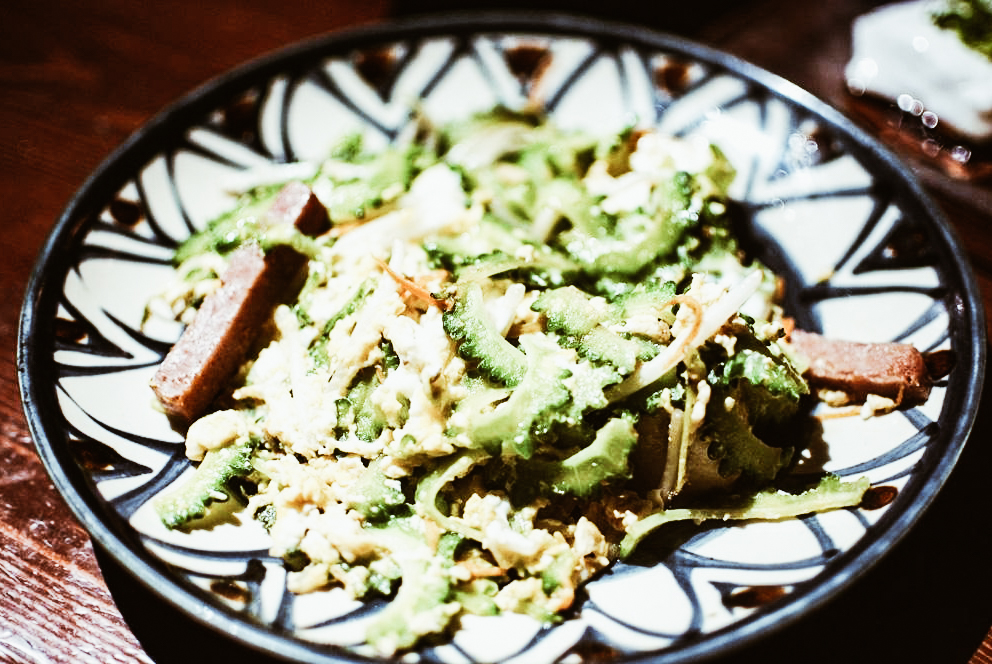

photo credits: ohayo.it
"Eating like a rainbow"
In the words of Dr Willcox, by virtue of the parade of colours that the great variety of fruit and vegetables brings to the tables of Okinawa. Variety. Another watchword in the agenda of the Okinawans who would use at least 18 foods daily. The important thing, however, is always to respect the seasonality of the fruit and vegetables. In this way, the maximum nutritional potential of the fruit and vegetables can be realised. And of course, the freshness of the food. It is also important if you decide to cook them, especially when it comes to fish and vegetables: never overcook them if you want to preserve the nutrients!
In addition to very low consumption of carbohydrates, salt and sugar are also used very little. Yes to spices, such as turmeric, and mushrooms.
What about meat?
As a result of that Chinese influence mentioned at the beginning, meat consumption is also well established in Okinawa's cuisine. But meat, as well as dairy products and cereals, are categories with a high nutritional density...so they are consumed in even smaller quantities! Even rice is eaten less than the rest of Japan and quinoa is often preferred to rice. We speak of a low-calorie diet also for this reason; because it counterbalances with smaller quantities of nutritional contributions otherwise potentially excessive. Also because vegetable and marine foods and fruit remain the true carriers of all those beneficial substances that make up the food elixir of Okinawa.
#2 Motor and mental activity
"When the body moves, the brain goes into rhythm" - this is the motto of Jim Kwik, an internationally renowned trainer who deals with fast learning. Kwik always urges even those who have to spend their days sitting down for work or study not to stay in the chair all the time but to take breaks and move around. Even just a few minutes of simple movements between breaks, as well as drinking water and making small snacks, are enough. In doing so, Kwik suggests, our performance is even better, because the brain works better if we treat ourselves this way. Exercise as a stimulator of neurogenesis and neuroplasticity: facilitates the creation of new neural connections. In short, physical movement is also a gym for the brain! That comes out strengthened. And if the brain is active the whole organism benefits. It is a vicious, beneficial circle that, when activated, becomes self-feeding. And this is also the basis for all the nutritional discourse that has just been made, as well as the other factors that we will see in a moment. Let us bear in mind that this discourse is not compartmentalised: everything is connected.
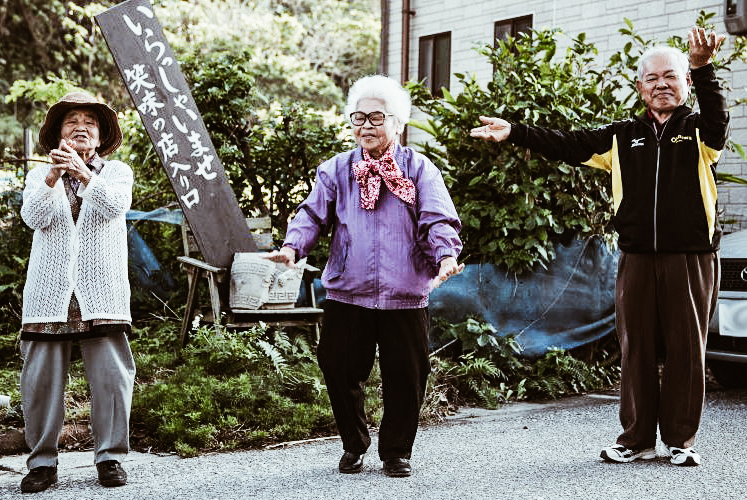
photo credits: okinawa.stripes.com
Observing the lives of our Okinawans, we find that, in their own way, they put into practice very similar things to those promoted by Mr. Kwik. The second reason for their well-being lies in the fact that they are active, not only in their body but also in their mind! The grandfather we see in the hyena service, for example, reads the newspaper every day when he returns from his morning walk. And watch out, 100 years go by, he does so without the help of glasses. Not to mention the fact that he worked in the countryside until he was 97 years old!
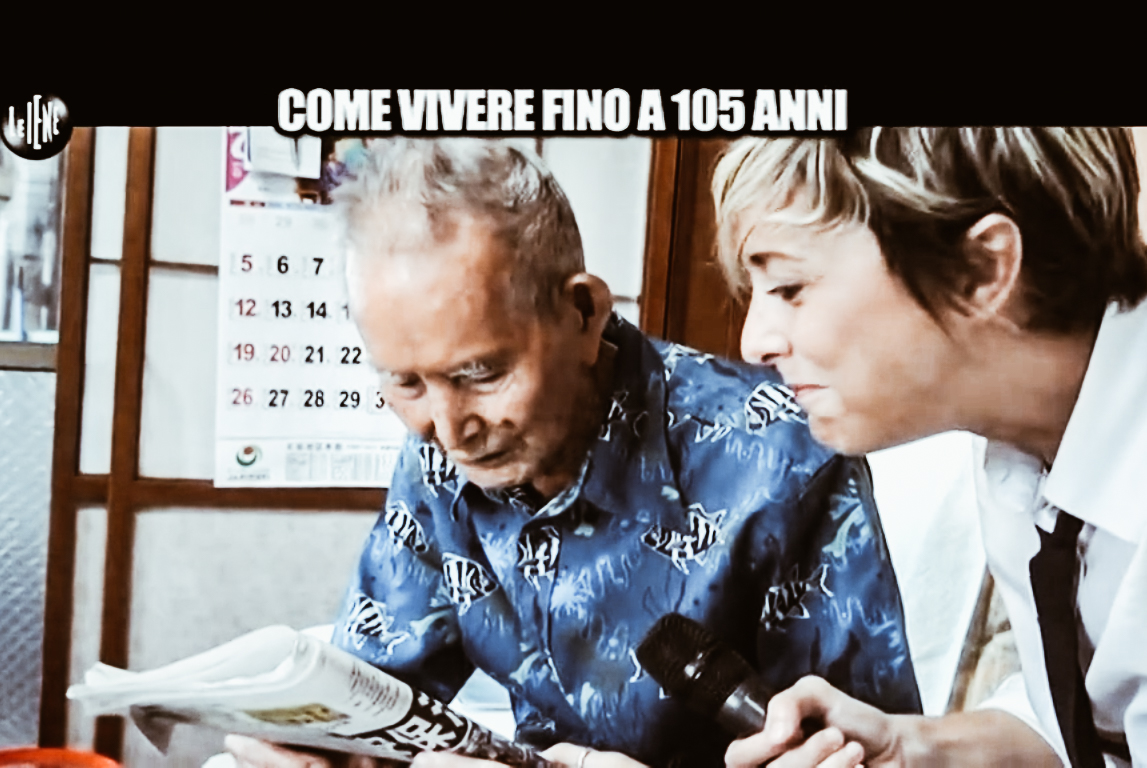
photo credits: mediaset.it
Among the activities most loved by Okinawa's grandparents - in addition to the garden, as already mentioned - we find traditional dance or dabbling with some traditional musical instrument. Or, martial arts, ideal for the body-mind-spirit system, as in the case of master Seikichi Uehara. Uehara, a few years before his death at the age of 100, still taught Karate to his students. Or again: how not to mention the weaver Toshiko Taira who, at the age of 100, continues to work as a weaver of Bashōfu, an ancient fabric used for the Kimono (produced only at Ōgimi).
#3 Interior and exterior attitude
But it's not just a question of genes and nutrition. Turn that turns you back, you always come back there: the mind (and the spirit, which in the Japanese vision is one with the mind - as the parola心 "Kokoro" or heart/mind) testifies. Once again, the vision of things proves to be decisive. The most cynical ones will be tired of always hearing "the same old tune", I know; but instead of automatically throwing it on scepticism, I would start to give more credit to the "power of the mind". There will be a reason for this if it is invoked from many quarters. Those who have somehow experienced the beneficial influences of a clean mindset, from excessively... interpretative distortions of reality, let's put it this way.
The perception of the world and therefore of oneself has the power to affect the tangible world of people. Let's think about psychosomatic illnesses for example...or even just inner dialogue: thoughts or words directed towards something can influence this something, including ourselves.
Thus, even Okinawan scholars recognise optimism as a not inconsiderable factor, as well as more tangible factors. Optimism, attention, understood not as pretending that the challenges in life do not exist...but as a different way of accepting both the good and the bad. An openness towards life, which avoids complaining and the negative vision of things. A serenity given by knowing one's own soul and place in the world, with a consequent trust in life and in others. From giving the benefit of the possibility, to everything and everyone.
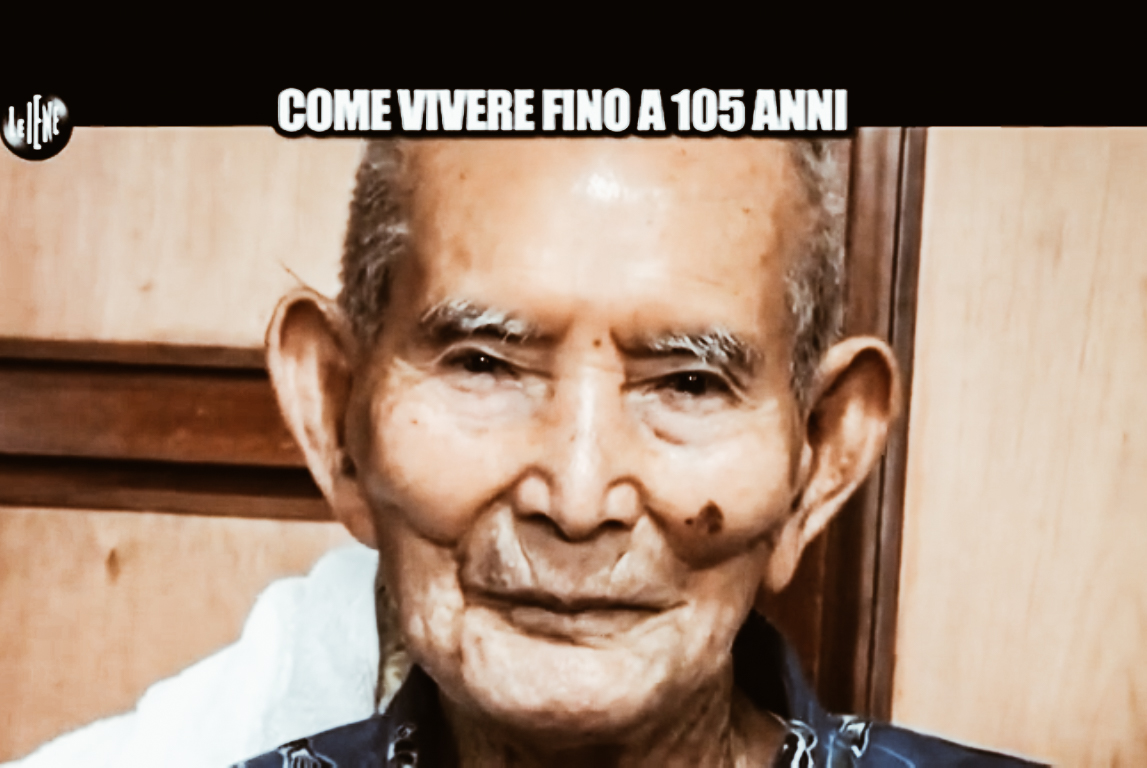
photo credits: mediaset.it
#4 Interpersonal relationships and social life
When this happens, the mind/spirit "machine" works properly and you feel better at 360 degrees. Even in the seemingly obvious little things that have their own importance, such as simple but authentic moments of conviviality. People in Okinawa generally have a very healthy social life, based on trust and balanced communication. It is often overlooked, precisely because it may seem like "the usual rhetoric", but, believe me, communication is essential to maintain healthy and satisfying human relationships. When people manage to have sincere, spontaneous, and serene communication - without any quarrels of any kind - the relationships are perfectly balanced. Without balanced and satisfying human relationships, the life of a human being is not the same. Just as moments of healthy solitude are essential, to rebalance oneself and recover one's energies, so, at a certain point, are human relationships. But be careful: they must be healthy and balanced. Just like those of our Okinawans.
The deep sense of belonging to the community that characterises their network of relationships and the value attributed to the elderly creates a buffer effect on the elderly that gives them confidence. With a community ready to support them, grandparents can thus live freely and still feel useful. Would you have me believe that the love and trust surrounding these people do not contribute to their quality of life?
#5 Spirituality
And all this takes us towards the last factor that remains for us to consider: spirituality. It "ferries us" because an approach to life like the one we have seen, from that part of the world, goes hand in hand with a certain kind of spiritual sensitivity. These two things are intimately linked if we think about it, and it could not be otherwise.
The philosophy of finding one's own reason to live, what gives it meaning, is from Okinawa, the famous Ikigai ( 生き甲斐 ). If this is missing, there is no healthy diet or strong genes to keep, for a long and quality life. Even the saying "Nan kuru nai sa ( なんくるないさ )" that is "Don't worry [it's all right] " is made in Okinawa. It indicates the profound belief that everything that happens in life has its own intrinsic meaning and that it serves us, for our growth. Having said that, everyone can and should do everything in his or her power in the situations that life confronts him or her with. If this is done, then the motto says to us "you have nothing to fear: everything you could do you have done, so it is all right, be at peace. Everything is as it should be".
Prayer and meditation, also beneficial against stress, are very present in the life of the Okinawans. In the morning, for example, they gather in front of an altar traditionally present in their homes to commemorate and thank their ancestors. This aspect of thanksgiving is something very important that potentially has an impact on the mentality and one's own worldview. And the same care of the vegetable garden already invoked higher up or even eating calmly (devoting all the attention to the act itself, without dispersing it with the TV, for example), is in truth in itself, already meditation.
Nature and environment
A spirituality in any case always close to nature...that recognizes the soul. Could it be that it is precisely the sharing with nature that has inspired these people over time to the right behaviour for a beneficial lifestyle? Although this specific aspect is difficult to quantify with empirical data, I believe so. Also because, if we take for granted that mentality and worldview can have power over our lives... why then discard a priori the power of the "spirit of nature"? Just like animals (think of pet-therapy), so can nature.
The spiritual is very present all over Japan but in Okinawa, it can count on a more uncontaminated nature, at least, compared to other places in the world. Let's remember that the increase in free radicals - potentially responsible for cancer - is also favoured by pollution as well as by bad behaviour. In order to link up with what we said at the beginning when we were thinking about the other blue areas, even the environmental factor - the ecosystem - has its own weight.
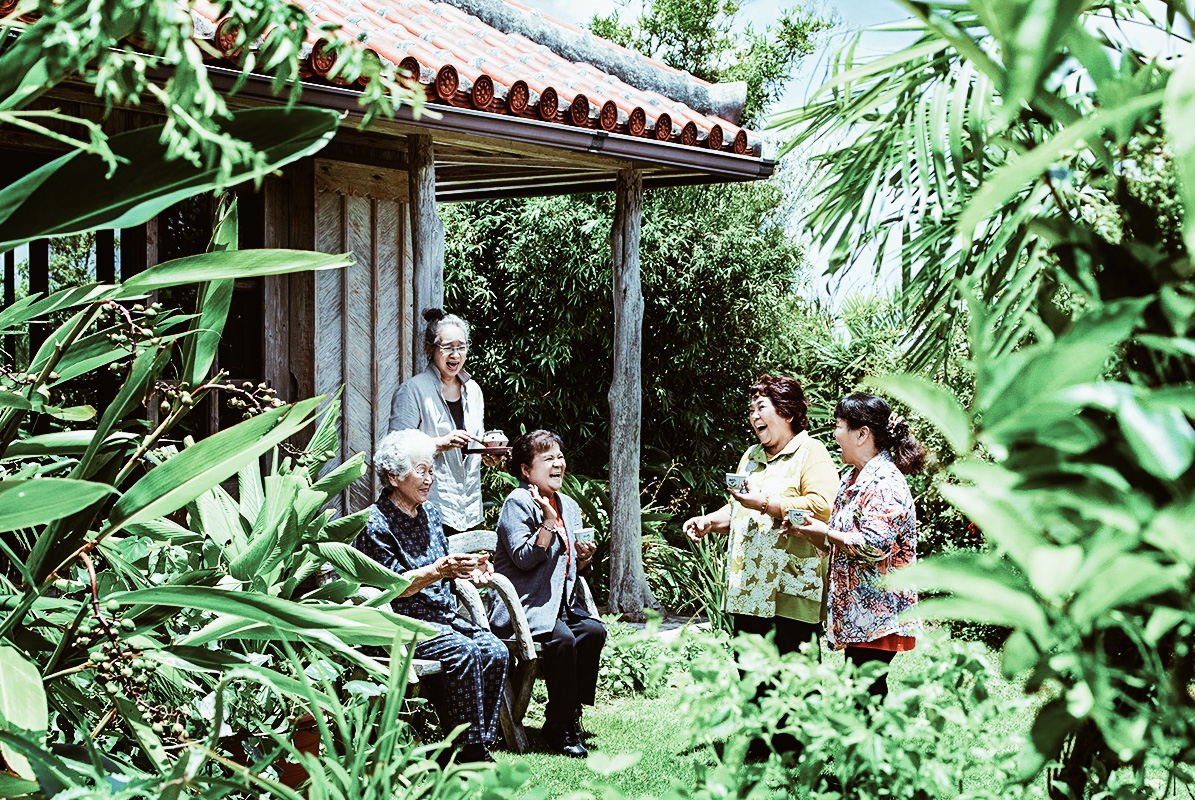
photo credits: visitokinawa.jp
The power of the Okinawa lifestyle
And so, alongside: healthy and balanced nutrition; the balanced activity of body and brain; a good relationship with life and consequently with others, here we have the spiritual dimension. But again, there is no hierarchy between these factors: just like the courses of the Japanese tables, they are all contemporary. Each one depends on the other and each influences the other. Of course, you will say, there is always a genetic predisposition. But while genes are not chosen, all these factors are in the hands of individuals. They are in their power. Good genes are undoubtedly a plus. However, as widely observed in OCS research, an individual with a healthy lifestyle lives better and for a long time, even without such a gene. While its effectiveness can also be cancelled out by the lack of just one of the other factors. This is already being demonstrated by the new generations of Okinawa. In fact, the young people of the area are at risk of losing the health benefits of their grandparents by becoming westernized between sedentariness and technology, consumption of pre-packaged food full of colourings.
Even in Italy, it is possible to have the same nutritional benefits as the Okinawa diet. After all, our Mediterranean diet, as Eugenio Iorio also tells us, is based on the same principles. Therefore, we also have the same food supplies in our lands and in our sea. We also talk about "MediterrAsian diet" if we try to integrate the two nutritional models. On the other hand, the Okinawa lifestyle and the Sardinian and Ikarian styles have some aspects in common: high consumption of vegetables and legumes, active and especially outdoor life, and finally, social life and strong family ties.
TENOHA &|TASTE: Hiroshima Hakken
The super wanted HAKKEN menu is back to TENOHA Milano and this time we fly to Hiroshima! Are you ready to start your trip again in the most beautiful Japanese prefectures?
TENOHA & | TASTE: Hiroshima 広島
Author: SaiKaiAngel
Hiroshima is a prefecture known for "Peace" and is located in southwest Japan, between the inland sea of Seto and the Chugoku Mountains, characterized by the Mediterranean climate. Apart from its very important history that unfortunately we all sadly know, Hiroshima has two UNESCO World Heritage sites and many other historical places to visit, for example, the Itsukushima sanctuary in Miyajima, the Peace Park Memorial and the Dome of the A-bomb.
So TENOHA Milano decides to start the new trip in Japan with the HAKKEN menu right from Hiroshima, but let's see what it is all about.
Hakken Hiroshima, menu
HIROSHIMA TSUKEMEN | 広島つけ麺
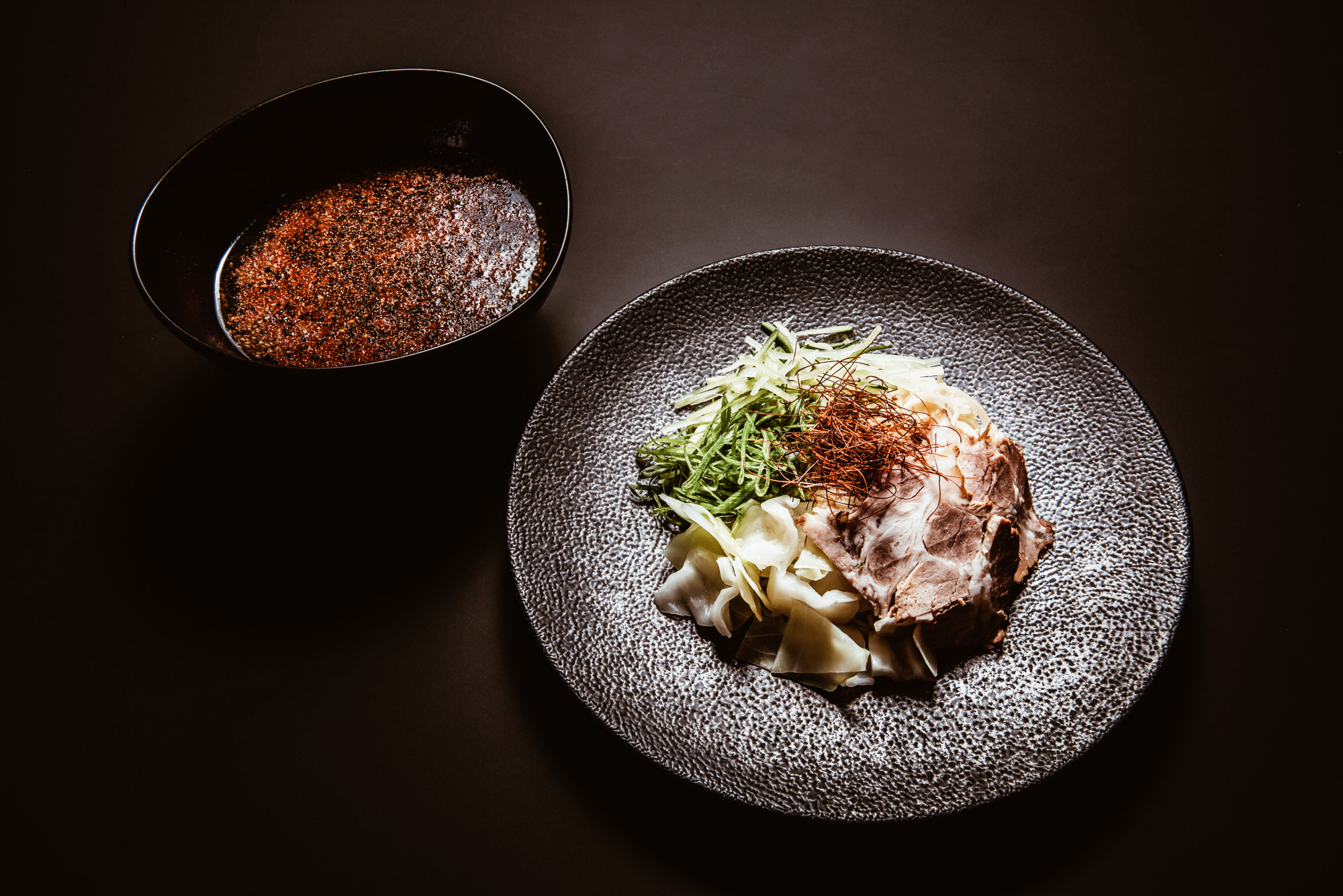
Japanese spaghetti with pork chashu, cabbage, spring onions and cucumber served with dashi broth and soy sauce. Vinegar and sesame are separate.
What is the name of this dish derived from? Tsukemen derives from "Tsukeru" which means dunking and "Men" which means noodles; in Hiroshima in particular, Tsukemen broth is seasoned with large amounts of shichimi pepper to make the broth super red and spicy.
When: Until 31 December, Monday - Friday at 12:00 - 15:00
Cost: 16 € (15 servings per day)
OKONOMIYAKI | 広島風お好み焼き
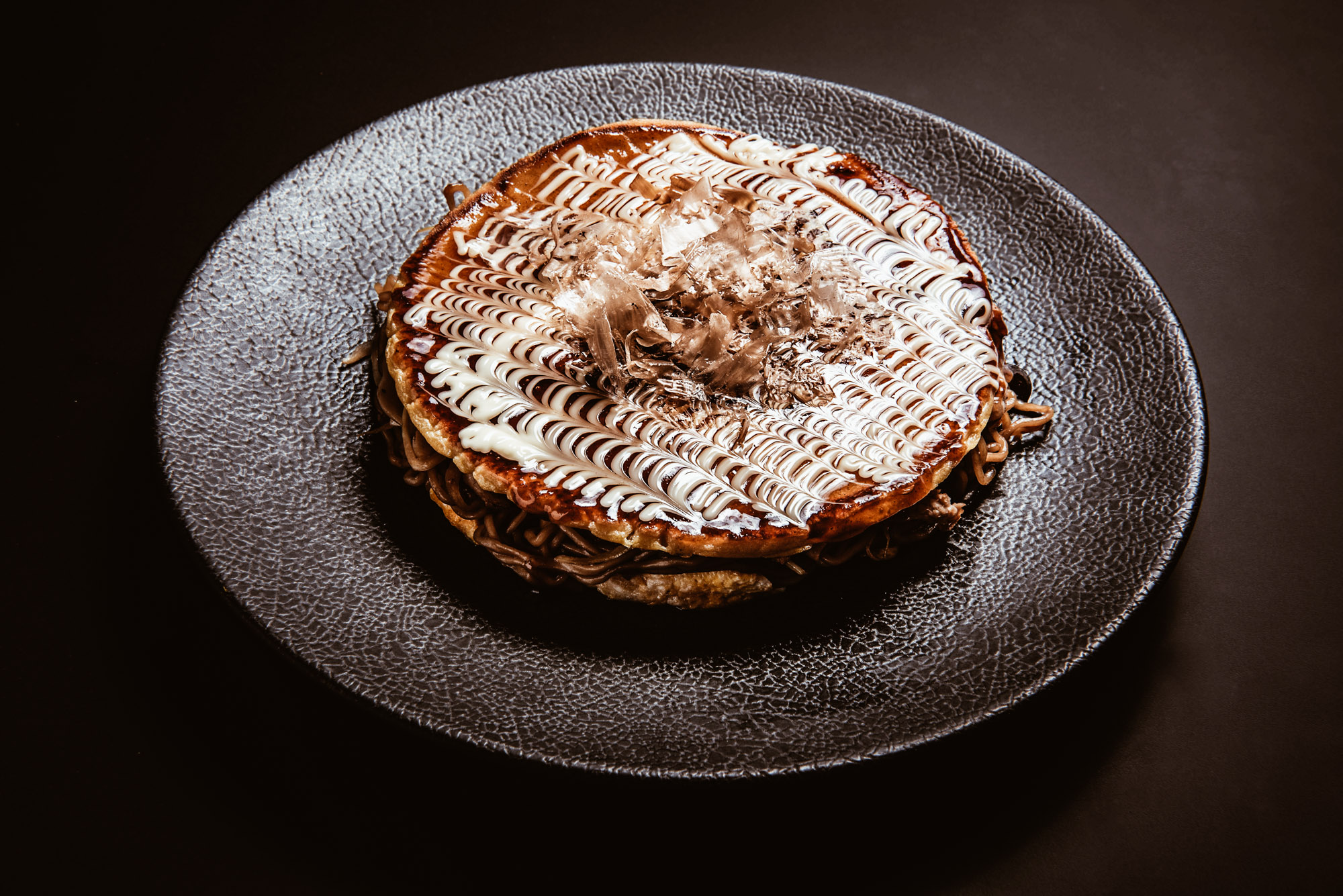
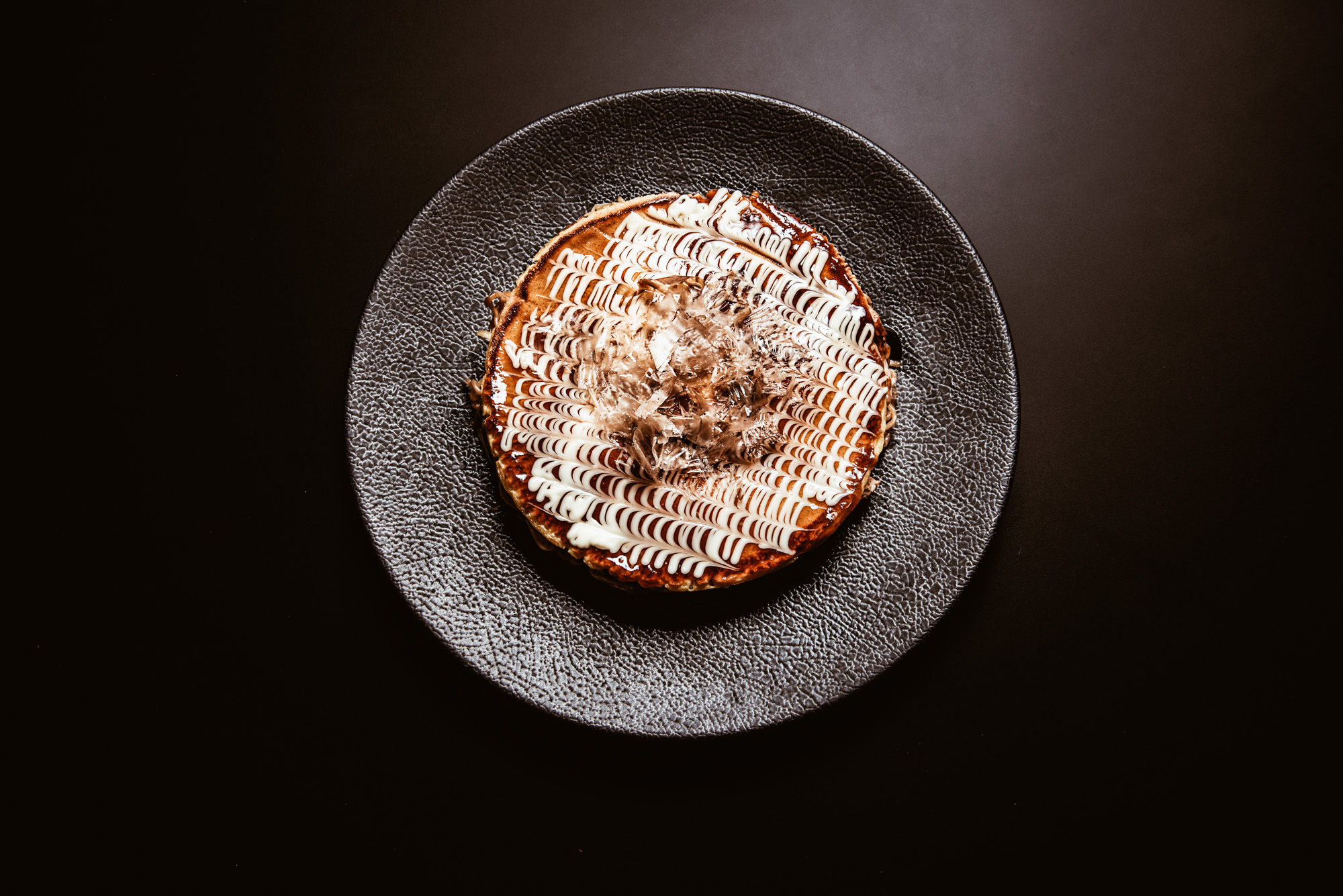
Japanese spaghetti with pork bacon, cabbage and spring onions all served with okonomiyaki sauce.
Hiroshima style okonomiyaki is described as "food of the soul". Usually, to make okonomiyaki the ingredients are all mixed together, but Hiroshima’s okonomiyaki is different: all the ingredients are laid on top of each other, so completely different attention.
When: Until 31 December, Monday - Friday at 12:00 - 15:00
Cost: 16 € (15 servings per day)
Sponsored by JNTO Japanese National Tourist Board
TENOHA & | RAMEN
ONOMICHI RAMEN | 尾道ラーメン
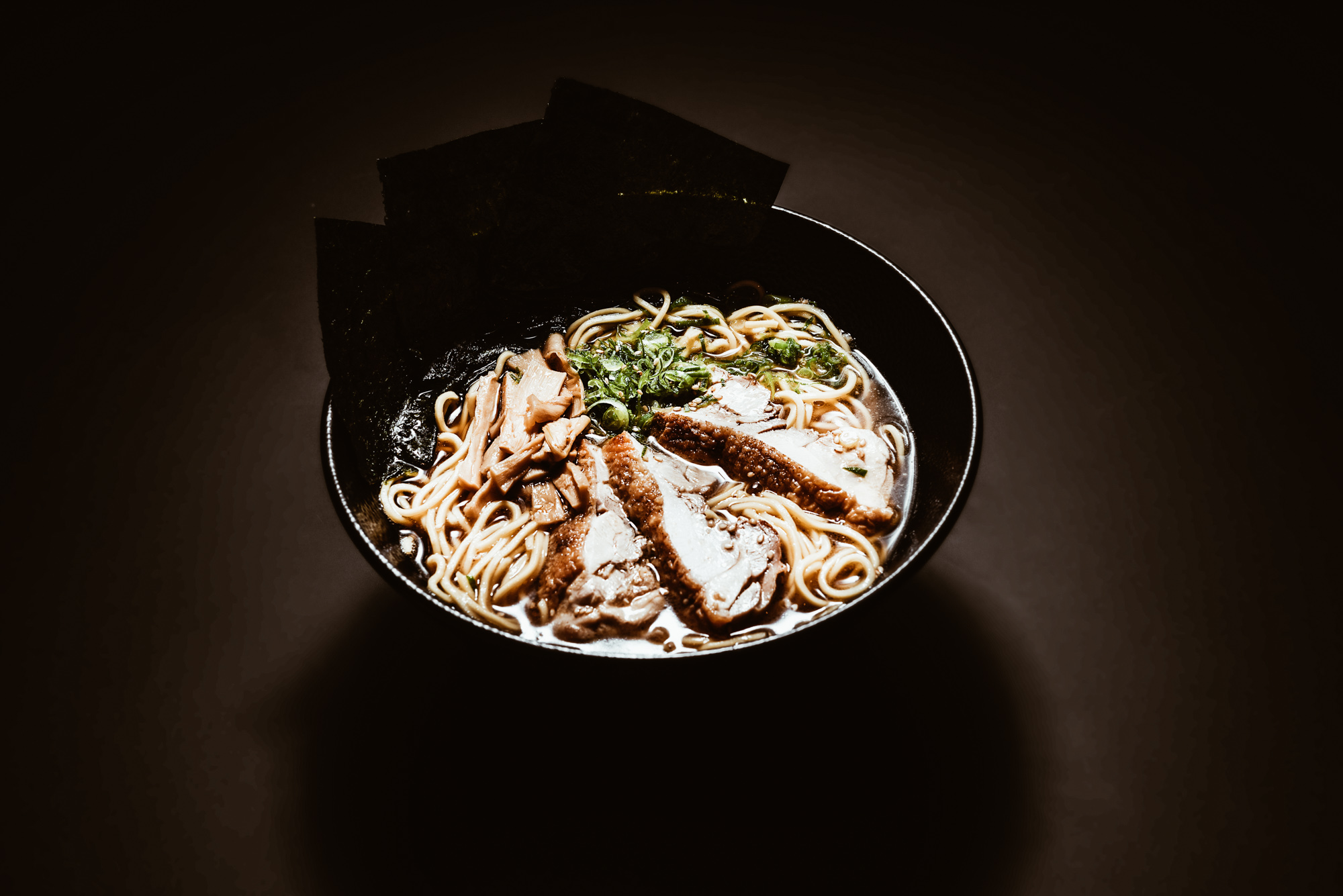
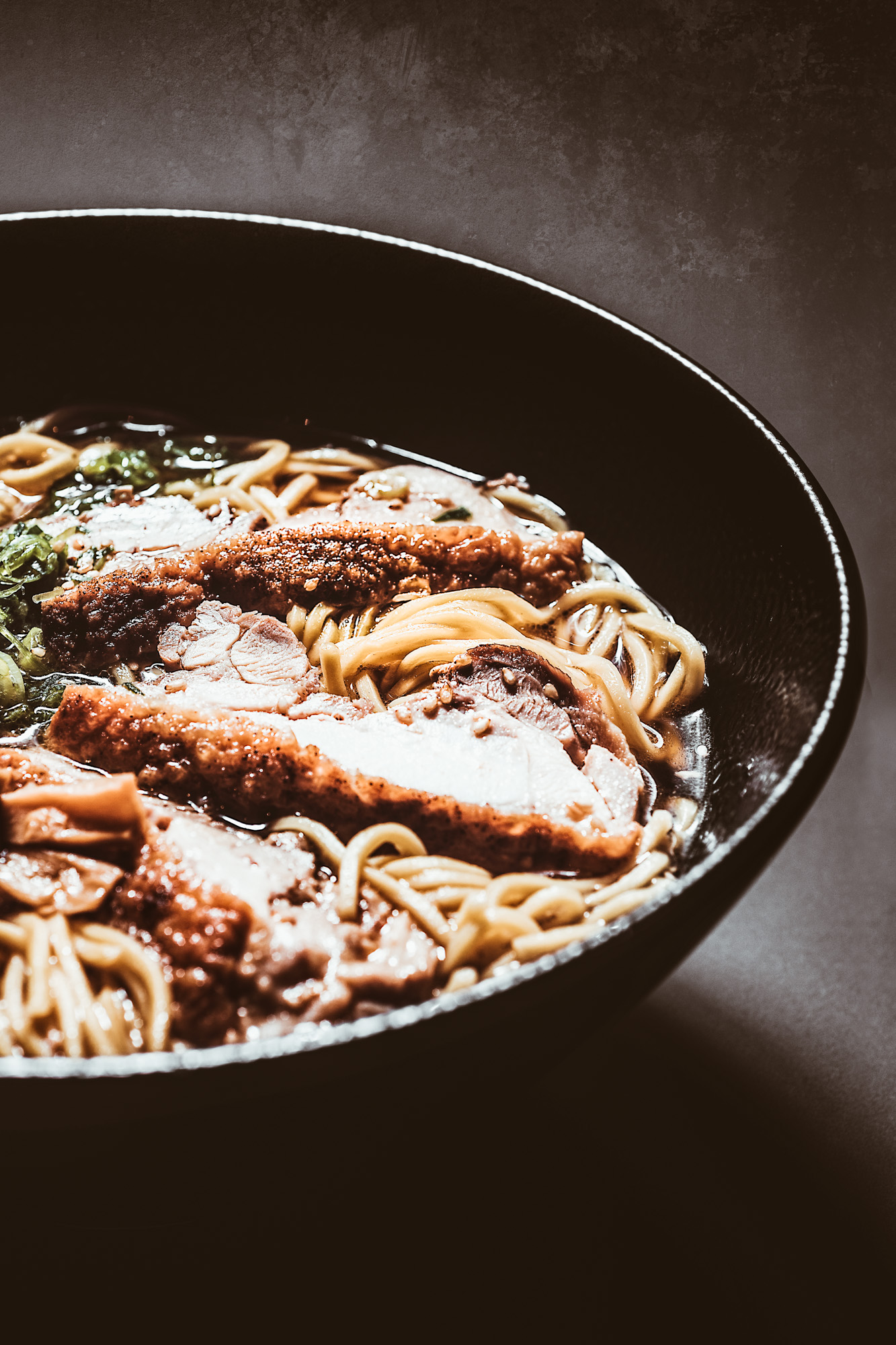
Ramen in soy fish broth, served with grilled chicken onions, onions, bamboo, nori seaweed and sesame
Onomichi Ramen is typical ramen from the prefecture of Hiroshima famous for its dashi with seafood from the sea of Setouchi. TENOHA is proud to present its Onomichi Ramen! Homemade Chashu Chicken called "Happy Chicken", which is bred stress-free and well cared for. In addition, the ramen is all handmade.
Come to TENOHA &| RAMEN to enjoy the Onomichi Ramen TENOHA version!
When: Until 31 December
Cost: 14 € (15 servings per day)
Sponsored by JNTO Japanese National Tourist Board
TENOHA & | SAKE
Not only delicious dishes but also unique sake for a really special tasting

Honshu ichi - Brasserie UmedaCo., Ltd.
Category】Junmai Ginjo
【Ingredients】Rice, Koji rice (Senbon Nishiki / Hiroshima product)
【Polishing ratio】60%
【Alcohol content】 16.8 °
【Glucose density】 1.8
【Acidity】1.7
【Sake Gradation】 +5
【Aroma】Sweet fruity aroma
【Pairing】Fish in general, chicken, sweets with strong flavor such as cheese cake
【Features】
A Junmai Ginjo Sake produced by Hiroshima Prefecture, preparing "Senbon Nishiki" rice with Hiroshima Ginjo yeast. It is characterized by the fruity aroma of Ginjo sake, slightly sweet taste. It can be enjoyed with fish and cheese dishes.
‘Zoka’ - Kamoizumi Shuzo Co., Ltd. 創業 1912年 founded in 1912
【Category】Junmai
【Ingredients】Rice, Koji, Water (Rice : Yamadanishiki/100% Higashiroshima )
【Polishing ratio】65%
【Alcohol content】16°
【Glucose density】2.0%
【Acidity】1.8
【Sake Gradation】±0
【Aroma】Sweet chestnut, with a strong smell of rice and wheat.
【Pairing】Boiled tofu, sweet with citrus fruits, marinated food.
【Features】
Junmai Daiginjo is made from "Yamada Nishiki" sake rice grown in a field located about 6 km north of the brewery, using Saijo underground water and the Hiroshima Mori technique. The delicate aroma and sweetness of the transparent and gentle rice harmonize perfectly with the fresh acidity. You can enjoy it cooled with a thin cup or glass of wine. Sake certified with Saijo JAPAN brand)
Itteki Nyukon - KamotsuruCo., Ltd.
【Category】Junmai Ginjoshu
【Ingredients】Rice, Koji rice(100% Hiroshima rice)
【Polishing ratio】60%
【Alcohol Gradation】15 - 16 °
【Glucose density】1.0
【Acidity】1.6
【Sake Gradation】+3
【Sweet】Aroma
【Pairing】Sauté of chicken, Gelée of white peaches
【Features】
This sake has as first material the rice suitable for its preparation. A slightly dry Junmai Ginjo sake that goes well with foods with the right acidity, good both cold and hot.
Sempuku Shinriki 【Nickname】Filled with happiness - Brasserie MiyakeCo., Ltd. Sempuku Shinriki
【Category】Saké Daiginjo
【Ingredients】Rice, Koji (Shinriki) rice
【Polishing ratio】 85%
【Alcohol content】 19.0 °
【Glucose density】 1.2
【Acidity】2.3
【Sake Gradation】 +5
【Aroma】Mature aroma, almond
【Pairing】Sukiyaki, Steak, Cheese, Chocolate
【Features】
Kamiriki rice, which is the origin of Chifuku, is 85% processed and is close to the processing speed of rice from the Meiji and Taisho eras. A bottle full of feelings for the preparation of sake, especially suitable for people who particularly care about Japanese sake.
Night Emperor - Fuji Shuzo
【Category】Junmai
【Ingredients】Rice, Hattan Nishiki Koji, Water
【Polishing ratio】65%
【Alcohol content】 15 °
【Glucose density】N/A
【Acidity】1.6
【Aroma】Moscato, walnuts
【Sake Gradation】 +9
【Pairing】Tartare, Lemon Grilled Chicken
【Features】
Night Emperor is a mixed Hachitan Nishiki based liqueur produced in Hiroshima Prefecture. Versatile liqueur easy to combine with any dish. Soft taste that takes advantage of the characteristics of fresh water preparation and keeps the alcohol content low while maintaining the taste of koji and rice. Good tasted both cold and hot.
Curious to try this Hiroshima Hakken?









